McGraw-Hill Education ACT 2017 (2016)
Part IV. THREE PRACTICE TESTS
ACT PRACTICE TESTS
These simulated tests should help you to evaluate your progress in preparing for the ACT. Take the tests under realistic conditions (preferably early in the morning in a quiet location), and allow approximately 3.5 hours for each entire test. Each of the test sections should be taken in the time indicated at the beginning of the sections, and in the order in which they appear. Fill in the bubbles on your answer sheet once you have made your selections.
When you have finished each test, check your answers against the Answer Key. Follow the directions on how to score your test. Then, read the Explanations, paying close attention to the explanations for the questions that you missed.
![]() ANSWER SHEET
ANSWER SHEET
ACT PRACTICE TEST 1
Answer Sheet
ENGLISH
1 ![]()
2 ![]()
3 ![]()
4 ![]()
5 ![]()
6 ![]()
7 ![]()
8 ![]()
9 ![]()
10 ![]()
11 ![]()
12 ![]()
13 ![]()
14 ![]()
15 ![]()
16 ![]()
17 ![]()
18 ![]()
19 ![]()
20 ![]()
21 ![]()
22 ![]()
23 ![]()
24 ![]()
25 ![]()
26 ![]()
27 ![]()
28 ![]()
29 ![]()
30 ![]()
31 ![]()
32 ![]()
33 ![]()
34 ![]()
35 ![]()
36 ![]()
37 ![]()
38 ![]()
39 ![]()
40 ![]()
41 ![]()
42 ![]()
43 ![]()
44 ![]()
45 ![]()
46 ![]()
47 ![]()
48 ![]()
49 ![]()
50 ![]()
51 ![]()
52 ![]()
53 ![]()
54 ![]()
55 ![]()
56 ![]()
57 ![]()
58 ![]()
59 ![]()
60 ![]()
61 ![]()
62 ![]()
63 ![]()
64 ![]()
65 ![]()
66 ![]()
67 ![]()
68 ![]()
69 ![]()
70 ![]()
71 ![]()
72 ![]()
73 ![]()
74 ![]()
75 ![]()
MATHEMATICS
1 ![]()
2 ![]()
3 ![]()
4 ![]()
5 ![]()
6 ![]()
7 ![]()
8 ![]()
9 ![]()
10 ![]()
11 ![]()
12 ![]()
13 ![]()
14 ![]()
15 ![]()
16 ![]()
17 ![]()
18 ![]()
19 ![]()
20 ![]()
21 ![]()
22 ![]()
23 ![]()
24 ![]()
25 ![]()
26 ![]()
27 ![]()
28 ![]()
29 ![]()
30 ![]()
31 ![]()
32 ![]()
33 ![]()
34 ![]()
35 ![]()
36 ![]()
37 ![]()
38 ![]()
39 ![]()
40 ![]()
41 ![]()
42 ![]()
43 ![]()
44 ![]()
45 ![]()
46 ![]()
47 ![]()
48 ![]()
49 ![]()
50 ![]()
51 ![]()
52 ![]()
53 ![]()
54 ![]()
55 ![]()
56 ![]()
57 ![]()
58 ![]()
59 ![]()
60 ![]()
READING
1 ![]()
2 ![]()
3 ![]()
4 ![]()
5 ![]()
6 ![]()
7 ![]()
8 ![]()
9 ![]()
10 ![]()
11 ![]()
12 ![]()
13 ![]()
14 ![]()
15 ![]()
16 ![]()
17 ![]()
18 ![]()
19 ![]()
20 ![]()
21 ![]()
22 ![]()
23 ![]()
24 ![]()
25 ![]()
26 ![]()
27 ![]()
28 ![]()
29 ![]()
30 ![]()
31 ![]()
32 ![]()
33 ![]()
34 ![]()
35 ![]()
36 ![]()
37 ![]()
38 ![]()
39 ![]()
40 ![]()
SCIENCE
1 ![]()
2 ![]()
3 ![]()
4 ![]()
5 ![]()
6 ![]()
7 ![]()
8 ![]()
9 ![]()
10 ![]()
11 ![]()
12 ![]()
13 ![]()
14 ![]()
15 ![]()
16 ![]()
17 ![]()
18 ![]()
19 ![]()
20 ![]()
21 ![]()
22 ![]()
23 ![]()
24 ![]()
25 ![]()
26 ![]()
27 ![]()
28 ![]()
29 ![]()
30 ![]()
31 ![]()
32 ![]()
33 ![]()
34 ![]()
35 ![]()
36 ![]()
37 ![]()
38 ![]()
39 ![]()
40 ![]()
You may wish to remove these sample answer document pages to respond to the practice ACT Writing Test.
![]()
ENGLISH TEST
45 Minutes – 75 Questions
DIRECTIONS: In the passages that follow, some words and phrases are underlined and numbered. In the answer column, you will find alternatives for the words and phrases that are underlined. Choose the alternative that you think is best and fill in the corresponding bubble on your answer sheet. If you think that the original version is best, choose “NO CHANGE,” which will always be either answer choice A or F. You will also find questions about a particular section of the passage, or about the entire passage. These questions will be identified by either an underlined portion or by a number in a box. Look for the answer that clearly expresses the idea, is consistent with the style and tone of the passage, and makes the correct use of standard written English. Read the passage through once before answering the questions. For some questions, you should read beyond the indicated portion before you answer.
PASSAGE I
A Focused Intelligence
Aviator Charles A. Lindbergh was undeniably a man of genius. In 1927, he was the first person to complete a successful flight from New York to Paris. Such success was not the result of academic ![]() and determination.
and determination.
1. A. NO CHANGE
B. excellence, but the result, of ingenuity,
C. excellence but the result of, ingenuity
D. excellence, but the result of, ingenuity
Throughout his childhood and early ![]() Charles Lindbergh was not interested in erudition. In 1918, with the United States in the throes of World
Charles Lindbergh was not interested in erudition. In 1918, with the United States in the throes of World ![]() Lindbergh eagerly agreed to return to the family farm to grow food for the war effort in exchange for his high school diploma. Though the small Minnesota
Lindbergh eagerly agreed to return to the family farm to grow food for the war effort in exchange for his high school diploma. Though the small Minnesota ![]() his passion was not for agriculture, but for things mechanical. When he expressed these interests to his parents, a congressman and a
his passion was not for agriculture, but for things mechanical. When he expressed these interests to his parents, a congressman and a ![]() encouraged him to obtain a more formal education.
encouraged him to obtain a more formal education.
2. F. NO CHANGE
G. adulthood, he,
H. adulthood, which was
J. adulthood,
3. A. NO CHANGE
B. War I;
C. War I,
D. War I, the result was that
4. F. NO CHANGE
G. farm thrived, under his care
H. farm thrived under his care,
J. farm being under his care
5. A. NO CHANGE
B. teacher. They
C. teacher, they
D. teacher; they
Lindbergh attended the University of Wisconsin to study engineering. However, Lindbergh’s penchant for “hands-on” learning, combined with a lack of scholarly discipline and study skills, ![]() academic probation after barely two years. Realizing that the only practical knowledge he had gained in college was through his participation in the Reserve Officers’ Training Corps (R.O.T.C.), Lindbergh dropped out of college, never to
academic probation after barely two years. Realizing that the only practical knowledge he had gained in college was through his participation in the Reserve Officers’ Training Corps (R.O.T.C.), Lindbergh dropped out of college, never to ![]()
6. F. NO CHANGE
G. resulted in
H. as a result of
J. primarily resulting from
7. A. NO CHANGE
B. return.
C. return in order to graduate.
D. return so that he could earn a college degree.
In 1922, after brief aviation training at the Nebraska Aircraft Corporation, Lindbergh spent two summers traveling from state to state, ![]() wing walker, parachutist, and skydiver.
wing walker, parachutist, and skydiver.
8. F. NO CHANGE
G. performing, as a barnstormer
H. performing; as a barnstormer,
J. performing as a barnstormer,
Having found his true passion as a ![]() enlisted in the Army along with 103 other cadets. Despite his aversion to classroom learning, he
enlisted in the Army along with 103 other cadets. Despite his aversion to classroom learning, he ![]() his efforts and learned to truly study during ground school. Failing any one test would have resulted in being “washed out,” but Lindbergh passed his tests with “flying” colors.
his efforts and learned to truly study during ground school. Failing any one test would have resulted in being “washed out,” but Lindbergh passed his tests with “flying” colors. ![]() only eighteen cadets remained, and Lindbergh achieved the highest ranking among all of the members of his class.
only eighteen cadets remained, and Lindbergh achieved the highest ranking among all of the members of his class.
9. A. NO CHANGE
B. pilot. Lindbergh
C. pilot; Lindbergh
D. pilot Lindbergh
10. F. NO CHANGE
G. has focused
H. was focusing
J. focuses
11. A. NO CHANGE
B. At graduation, which was in 1925,
C. When he graduated in 1925,
D. When, in 1925, graduation came
![]() his disinterest in formal education, Lindbergh displayed an enjoyment of learning throughout his life,
his disinterest in formal education, Lindbergh displayed an enjoyment of learning throughout his life, ![]() new challenges. He charted transcontinental and transoceanic air routes that are still used today. His sister-in-law’s fatal heart condition
new challenges. He charted transcontinental and transoceanic air routes that are still used today. His sister-in-law’s fatal heart condition ![]() which enabled a damaged heart to continue pumping while doctors worked to repair it.
which enabled a damaged heart to continue pumping while doctors worked to repair it. ![]()
12. F. NO CHANGE
G. Even though
H. Due to
J. Because of
13. A. NO CHANGE
B. sought out and accepting
C. seeking out and accepting
D. seeks out and accepts
14. F. NO CHANGE
G. led to his work with surgeon Alexis Carrel in developing a perfusion pump
H. led to the development of a perfusion pump with surgeon Alexis Carrel
J. led to the surgeon Alexis Carrel and his work with him to develop a perfusion pump
15. Which of the following choices (assume all are true) should the writer use here to provide an appropriate conclusion to the essay?
A. Charles Lindbergh dedicated his efforts to becoming a pilot.
B. Charles Lindbergh will be best remembered for his trans-Atlantic flight in 1927.
C. Charles Lindbergh developed cancer and spent his last days in Hawaii.
D. Charles Lindbergh could look back with the wisdom of life’s experiences, knowing that he had focused his intelligence in untraditional ways and changed the world.
PASSAGE II
Crude Sophistication
The Vikings of Scandinavia (what is now Norway, Sweden, and Denmark) led what would today be considered a crude existence. In many ways, ![]() they were far more advanced than their contemporaries.
they were far more advanced than their contemporaries. ![]() In fact, to a great extent, Vikings seemed more at home on the ocean than did other European cultures even centuries later.
In fact, to a great extent, Vikings seemed more at home on the ocean than did other European cultures even centuries later.
16. The writer wants to emphasize that the Vikings, though crude in many ways, were sophisticated in many others. Which choice does that best?
F. NO CHANGE
G. similarly,
H. however,
J. to that end,
17. Which of the following sentences, if inserted here, would best illustrate the accomplishments of the Vikings?
A. Vikings were very loyal to family members, even if they did something wrong.
B. Vikings gained much of their wealth by robbing and plundering, finding easy victims in Christian monasteries.
C. Vikings traveled far and wide.
D. Although Christopher Columbus is credited with “discovering” America in 1492, Viking explorers appear to have reached North America much earlier.
The Vikings were among the first international ![]() purpose-built,
purpose-built, ![]() Vikings sailed from Scandinavia through the Straits of Gibraltar to the eastern Mediterranean. These intrepid explorers also crossed the Atlantic Ocean, settling in Iceland and Greenland. From there,
Vikings sailed from Scandinavia through the Straits of Gibraltar to the eastern Mediterranean. These intrepid explorers also crossed the Atlantic Ocean, settling in Iceland and Greenland. From there, ![]() crossed a much shorter distance to the North American continent, where archaeological evidence of their landing has been found in what is now northern Newfoundland, Canada. Regardless of whether Vikings arrived
crossed a much shorter distance to the North American continent, where archaeological evidence of their landing has been found in what is now northern Newfoundland, Canada. Regardless of whether Vikings arrived ![]() distant travel during the ninth to twelfth centuries is quite remarkable.
distant travel during the ninth to twelfth centuries is quite remarkable.
18. F. NO CHANGE
G. seafaring traders: with
H. seafaring traders, with,
J. seafaring traders with
19. A. NO CHANGE
B. trading ships constructed of wooden products.
C. wooden ships for trading.
D. ships, constructed of wood, for trading.
20. F. NO CHANGE
G. the Vikings
H. the Vikings of Scandinavian origin
J. ancient Scandinavian Vikings
21. A. NO CHANGE
B. first, their
C. first: their
D. first; they’re
Vikings were skillful boatbuilders and sailors. Their ancient marinas included small river boats, ocean-going cargo ships, and even warships used to raid their Christian neighbors. Viking traders sailed ![]() the Baltic sea, obtaining furs and amber. In Russia, they
the Baltic sea, obtaining furs and amber. In Russia, they ![]() up and traded goods with Arab traders carrying silks and spices.
up and traded goods with Arab traders carrying silks and spices.
22. Which of the following alternatives to the underlined portion would NOT be acceptable?
F. over
G. across
H. into
J. on
23. A. NO CHANGE
B. met
C. would meet
D. would be meeting
Vikings possessed many complicated skills and were fine craftsmen. For example, their steel sword and ax blades were ![]() Similar craftsmanship was used by leather workers on shoes, harnesses, and saddlery. Viking women also possessed diverse
Similar craftsmanship was used by leather workers on shoes, harnesses, and saddlery. Viking women also possessed diverse ![]() butter, cheese, and ale, and often weaving intricate geometric designs into their multi-colored
butter, cheese, and ale, and often weaving intricate geometric designs into their multi-colored ![]()
24. Given that all of them are true, which choice supports the paragraph by giving the most specific details?
F. NO CHANGE
G. well made.
H. often inlaid with intricate designs in silver.
J. made of steel.
25. A. NO CHANGE
B. skills; making
C. skills and included making
D. skills, including making
26. F. NO CHANGE
G. fabrics; fabrics like those used in today’s clothes.
H. fabrics—clothes are made from fabrics.
J. fabrics.
One way in which the Vikings were behind their contemporaries was in reading and writing. Few Vikings could read or write, so those who could ![]() valuable. Records of brave deeds were etched on large standing stones called runes.
valuable. Records of brave deeds were etched on large standing stones called runes. ![]() were made up of sixteen different symbols. Because so few Vikings could read, they believed that runes
were made up of sixteen different symbols. Because so few Vikings could read, they believed that runes ![]() magical and could be used to cast spells. Because they wrote down very little of their history or beliefs, most of what is known of the Vikings today is the result of archaeologists’ discoveries and
magical and could be used to cast spells. Because they wrote down very little of their history or beliefs, most of what is known of the Vikings today is the result of archaeologists’ discoveries and ![]() .
.
27. A. NO CHANGE
B. was considering
C. that were considerate
D. considered
28. F. NO CHANGE
G. These rune’s
H. These runes
J. They’re runes
29. A. NO CHANGE
B. had been
C. were being
D. was being
30. The writer wants the final statement to reflect information previously provided in the essay. Given that all of the following concluding phrases are true, which one, if inserted here, would do that best?
F. written records of people who met them, such as their Christian neighbors (and victims) and the Arabs with whom they traded.
G. other research.
H. some recovered runes, which were often used by the archaeologists to cast spells and make predictions.
J. the testimonies of Scandinavian immigrants to America.
PASSAGE III
The following paragraphs may or may not be in the most logical order. You may be asked questions about the logical order of the paragraphs, as well as where to place sentences logically within any given paragraph.
Everybody Loves Kari
[1]
Kari has always been ![]() my favorite cousins. We were allies against the older, bigger cousins in games of hide-and-seek. But
my favorite cousins. We were allies against the older, bigger cousins in games of hide-and-seek. But ![]() isn’t specific to me—it’s universal!
isn’t specific to me—it’s universal! ![]() pretty face and innocent expression make her irresistible to boys. Her genuine concern for others combined with her occasional for-getfulness makes her unthreatening among
pretty face and innocent expression make her irresistible to boys. Her genuine concern for others combined with her occasional for-getfulness makes her unthreatening among ![]() gregarious nature juxtaposed with a genuine sweetness appeals to adults. Despite her overwhelming popularity, Kari’s congeniality occasionally gets her into trouble.
gregarious nature juxtaposed with a genuine sweetness appeals to adults. Despite her overwhelming popularity, Kari’s congeniality occasionally gets her into trouble.![]()
31. A. NO CHANGE
B. one with
C. one of
D. one being
32. F. NO CHANGE
G. the appeal of Kari
H. the appealingness of Kari
J. Kari’s level of appeal
33. A. NO CHANGE
B. She’s
C. It’s her
D. Her
34. F. NO CHANGE
G. girls, so her
H. girls, with her
J. girls, and her
35. Which of the following sentences, if added here, would most effectively signal the essay’s shift in focus occurring at this point?
A. Congeniality is defined as “pleasantness,” “sociability,” or “geniality.”
B. Take the time she was chosen to represent her home town at the American Legion Auxiliary Girls State convention.
C. Kari doesn’t get into trouble with the law—just embarrassing situations like you see on television comedies.
D. I could give you many examples.
[2]
Girls State provides promising high school juniors the opportunity ![]() hands-on citizenship training. They learn about government by electing each other as public officials on the local, county, and state levels and then by carrying out the respective duties of their offices. From each Girls State convention, two Senators are chosen to continue on to Girls Nation. Kari
hands-on citizenship training. They learn about government by electing each other as public officials on the local, county, and state levels and then by carrying out the respective duties of their offices. From each Girls State convention, two Senators are chosen to continue on to Girls Nation. Kari ![]() to be one of her state’s senators.
to be one of her state’s senators.
36. F. NO CHANGE
G. of participating for
H. in participation of
J. to participate in
37. A. NO CHANGE
B. was of course chosen:
C. was of, course chosen,
D. was, of course, chosen
[3]
At Girls Nation, the ![]() packed from morning until night, with one exception: the girls were allowed one afternoon to sight-see according to their own agenda. Kari had been sightseeing for about five minutes when she
packed from morning until night, with one exception: the girls were allowed one afternoon to sight-see according to their own agenda. Kari had been sightseeing for about five minutes when she ![]() a nice, young military
a nice, young military ![]() to show her around the nation’s capital. After a fun (and surprisingly educational) day together, Kari vowed to write often. Unlike most people
to show her around the nation’s capital. After a fun (and surprisingly educational) day together, Kari vowed to write often. Unlike most people ![]()
38. F. NO CHANGE
G. schedule being
H. schedules, some were
J. schedules was
39. A. NO CHANGE
B. met
C. had meeted
D. had a meeting with
40. F. NO CHANGE
G. cadet, who, gallantly offered
H. cadet who gallantly offered:
J. cadet, who gallantly offered
41. A. NO CHANGE
B. who promise to write, Kari actually does.
C. Kari actually does write when she promises she’ll write.
D. to whom they promise to write, Kari does it.
[4]
[1] Kari and the cadet were pen pals for several months until one fateful day when Kari wrote to a girlfriend from camp. [2] Her letter to her girlfriend was newsy and filled with many confidences. [3] Kari had attended three proms (with three different boys) that spring, and she had enjoyed herself at each. [4] Her favorite, however, had been with a very cute boy from a town 100 miles away. [5] (How Kari met him is another long story, the details of which she did not omit in her letter to her girlfriend.) ![]() [6] The same day, Kari wrote a letter to the cadet. [7] However, out of consideration for the hard-working young man, she omitted information about the many social events she had recently attended. [8] A week later, she received a brief note from the cadet with her letter returned. [9] It said, “I believe you intended the enclosed letter for another friend.”
[6] The same day, Kari wrote a letter to the cadet. [7] However, out of consideration for the hard-working young man, she omitted information about the many social events she had recently attended. [8] A week later, she received a brief note from the cadet with her letter returned. [9] It said, “I believe you intended the enclosed letter for another friend.” ![]() In her haste to send the letters, Kari had inadvertently mixed up the addresses.
In her haste to send the letters, Kari had inadvertently mixed up the addresses. ![]()
42. The writer had considered deleting the italics on the word not in the preceding sentence and revising did not to read as the contraction didn’t. If the writer had done this, the sentence would have lost its:
I. emphasis on the difference between Kari’s letter to her girlfriend and her letter to the cadet.
II. implication that this information was insignificant in the letter.
III. suggestion that this information would be critical later in the essay.
F. I only
G. III only
H. I and II only
J. I and III only
43. The writer is considering the division of Paragraph 4 into two separate paragraphs. In terms of the logic and coherence of the essay, the best course of action to take would be to:
A. begin a new paragraph with Sentence 3.
B. begin a new paragraph with Sentence 4.
C. begin a new paragraph with Sentence 6.
D. begin a new paragraph with Sentence 7.
44. The writer wishes to add a light note at this point, supporting the essay’s sense of completion by tying the ending back to the essay’s beginning. Given that all are true, which choice would best accomplish this?
F. NO CHANGE
G. Okay, so almost everybody loves Kari!
H. Kari’s friend wrote back immediately.
J. The cadet eventually left the military.
Question 45 asks about the preceding passage as a whole.
45. Suppose the writer had been assigned to write an essay describing the many opportunities that Girls State offered to high school juniors. Would this essay successfully fulfill the assignment?
A. Yes, because the essay indicates that Girls State offers many opportunities to high school juniors.
B. Yes, because Kari was selected to be one of her state’s senators.
C. No, because the essay proves that Girls State did not provide high school juniors with any opportunities.
D. No, because the essay is a personal recollection of a favorite cousin.
PASSAGE IV
The following paragraphs may or may not be in the most logical order. You may be asked questions about the logical order of the paragraphs, as well as where to place sentences logically within any given paragraph.
Field of Error
[1]
“Hey, Clint!” I shouted. “Did you know that each stalk of corn only has one ear of corn on it?”
“No way! That seven-foot tall stalk only produces one ear of corn?”
“Really! Isn’t that amazing? Get it? A-maize-ing!”
[2]
Have you ever asserted yourself as an expert, only to have your “expertise” challenged and proven wrong? The experience can ![]() embarrassing, and seemingly never-ending.
embarrassing, and seemingly never-ending.
46. F. NO CHANGE
G. be humbling,
H. be, humbling
J. be humbling
[3]
![]() In the course of doing my chores, I picked up a few bits of trivia—like the one-ear-of-corn-per-stalk information. After high school, I went away to
In the course of doing my chores, I picked up a few bits of trivia—like the one-ear-of-corn-per-stalk information. After high school, I went away to ![]() took great pains to ensure that I always had summer jobs lined up that did not involve farm labor.
took great pains to ensure that I always had summer jobs lined up that did not involve farm labor.
47. A. NO CHANGE
B. On a farm in Iowa, I grew up where I spent my evenings, weekends, and summers doing menial labor.
C. Performing menial labor in the evenings, on weekends and in summers, I grew up on a farm in Iowa where I did those things.
D. I grew up on a farm in Iowa where I spent my evenings, weekends, and summers performing menial labor.
48. F. NO CHANGE
G. college and
H. college,
J. college
[4]
After college, I moved to the city, where my friends enjoyed hearing occasional anecdotes and bits of trivia about life on the farm. ![]() the truth as I knew it had changed.
the truth as I knew it had changed.
49. A. NO CHANGE
B. Unfortunately,
C. In other words,
D. Hence,
[5]
Apparently, while I was away at college and beginning my career, genetic engineering had been ![]() the field of agriculture, and corn stalks now regularly sported two ears of corn instead of one.
the field of agriculture, and corn stalks now regularly sported two ears of corn instead of one. ![]() .
.
50. F. NO CHANGE
G. applied by
H. applied with
J. applied for
51. A. NO CHANGE
B. This, I learned, the hard way.
C. I learned something like this the hard way.
D. The hard way is how I learned this.
[6]
![]() as Clint and his friends were golfing and about to tee off
as Clint and his friends were golfing and about to tee off ![]() Clint spied a cornfield.
Clint spied a cornfield. ![]() “Hey guys! I’ll bet you ten bucks that not one stalk of corn out there has more than one ear on it.” “You’re crazy!” they replied. “We’ll take that bet!” And so Clint lost ten dollars and some measure of pride.
“Hey guys! I’ll bet you ten bucks that not one stalk of corn out there has more than one ear on it.” “You’re crazy!” they replied. “We’ll take that bet!” And so Clint lost ten dollars and some measure of pride. ![]() all credibility.
all credibility. ![]() and I still cannot see Clint
and I still cannot see Clint ![]() of that lost bet.
of that lost bet. ![]()
52. F. NO CHANGE
G. One day in the past
H. One day long ago
J. One day, a while back,
53. A. NO CHANGE
B. from the fifth of eighteen holes,
C. on the golf course,
D. DELETE the underlined portion.
54. At this point, the writer would like the reader to imagine the emotion and motivation behind Clint’s next words. Which of the following sentences, if added here, would most effectively accomplish this?
F. “Here’s a bet I’m sure to win!” he thought to himself.
G. “Golfing is a dumb game,” he mused.
H. “I know something about corn,” he said.
J. “There’s a cornfield,” Clint thought to himself.
55. A. NO CHANGE
B. I, on the other hand lost
C. I on the other hand, lost,
D. I, on the other hand, lost
56. F. NO CHANGE
G. Now, after ten long years,
H. It’s been ten years,
J. Ten long years have gone by,
57. A. NO CHANGE
B. without his reminding me
C. without being reminded by him
D. without receiving a reminder from him
58. The writer would like to add an introductory sentence to Paragraph 6 that shows why Clint challenged his friends. Which of the choices does that best?
F. My childhood friend Clint likes to make small bets with his golfing buddies.
G. My friend Clint has been to Las Vegas many times.
H. My friend Clint loves to golf.
J. My friend Clint has a degree in accounting.
Questions 59 and 60 ask about the preceding passage as a whole.
59. The writer is considering adding the following sentence to the essay, in order to emphasize that she did not intentionally mislead her friends.
With the exception of occasionally exaggerating some of the “characters” in my stories, I told my friends the truth.
If added, this new sentence would best support and be placed after the first sentence in Paragraph:
A. 2
B. 3
C. 4
D. 5
60. Suppose the writer had been assigned to write an article for a farming magazine that described the impact of genetic engineering on agriculture. Would this essay successfully fulfill the assignment?
F. No, because the essay describes the writer’s experience with the repercussions of authoritatively sharing outdated information.
G. No, because the essay focuses on the golf habits of her friend and does not describe genetic engineering in agriculture in detail.
H. Yes, because the essay focuses on how genetic engineering has increased corn yields.
J. Yes, because the essay states that cornstalks now contain two ears of corn where there previously was only one.
PASSAGE V
The Perfect Part-Time Job
Like most college students, I usually needed extra cash. However, I was a bit too discriminating in how I earned that money. Since my parents were paying my tuition, I couldn’t very well get a job that interfered ![]() classes, nor did I want to give up any of my extracurricular activities. Babysitting often fit within these parameters, only to find that it usually didn’t pay very well. I scoured the campus papers, only to find that the good jobs were always taken by the time
classes, nor did I want to give up any of my extracurricular activities. Babysitting often fit within these parameters, only to find that it usually didn’t pay very well. I scoured the campus papers, only to find that the good jobs were always taken by the time ![]() And then I found it—the perfect parttime job.
And then I found it—the perfect parttime job.
61. A. NO CHANGE
B. in
C. by
D. among
62. F. NO CHANGE
G. I called.
H. you could call.
J. you can call.
As I left my sociology class one day, I saw the flyer ![]() the door. “Help wanted for Psychology Dissertation Research—Acting Experience Preferred.” Normally, I avoided any opportunities that involved psychology research because
the door. “Help wanted for Psychology Dissertation Research—Acting Experience Preferred.” Normally, I avoided any opportunities that involved psychology research because ![]() generally involved some form of pain or deprivation for a meager
generally involved some form of pain or deprivation for a meager ![]() Nevertheless, I was intrigued by the
Nevertheless, I was intrigued by the ![]() since most of my extracurricular time was spent on stage, I decided this opportunity warranted a phone call.
since most of my extracurricular time was spent on stage, I decided this opportunity warranted a phone call.
63. A. NO CHANGE
B. it was just posted outside
C. posted just outside
D. it was posted just outside
64. F. NO CHANGE
G. they
H. it’s
J. of
65. A. NO CHANGE
B. stipend.
C. twenty to fifty-dollar stipend.
D. stipend. These are usually in the twenty to fifty-dollar range.
66. F. NO CHANGE
G. request for acting experience and
H. requesting acting experience, and
J. request for acting, experience, and
As it turned out, I was to be the ![]() the subject. And I did not have to inflict any pain. Essentially, I read the same series of questions to the
the subject. And I did not have to inflict any pain. Essentially, I read the same series of questions to the ![]() the experiment and
the experiment and ![]() to each subject’s answers. In some cases, I would say nothing and simply read the questions. In other cases, I would say things like, “Uh huh,” or “Yeah, that happened to me once!” At certain times, I kept my face devoid of emotion and made very little eye contact,
to each subject’s answers. In some cases, I would say nothing and simply read the questions. In other cases, I would say things like, “Uh huh,” or “Yeah, that happened to me once!” At certain times, I kept my face devoid of emotion and made very little eye contact, ![]() I nodded, smiled, leaned forward, showed concern, and so on in response to the subject’s answers. By combining these
I nodded, smiled, leaned forward, showed concern, and so on in response to the subject’s answers. By combining these ![]() responses, I played four different roles.
responses, I played four different roles.
67. A. NO CHANGE
B. experimenter, not
C. experimenter: and not
D. experimenter. Not
68. F. NO CHANGE
G. subjects with
H. subjects to
J. subjects on
69. A. NO CHANGE
B. various levels of feedback were provided
C. providing varying levels of feedback
D. provided varying levels of feedback
70. F. NO CHANGE
G. so at others
H. being at others
J. DELETE the underlined portion.
71. A. NO CHANGE
B. verbal, and nonverbal
C. verbal and nonverbal
D. verbal, and, nonverbal
[1] Although the pay was minimal, I found the work ![]() [2] I would have loved for the experiments to continue, but the research grant money was running low, and the experiments had already yielded definitive results. [3] All too soon, the experiments were completed. [4] To avoid inadvertently skewing the results, I was not allowed to know the researcher’s hypothesis ahead of time. [5] When the experiments were complete, my suspicions were confirmed: body language (nonverbal feedback) affects what (and how much) people tell you far more than anything you say.
[2] I would have loved for the experiments to continue, but the research grant money was running low, and the experiments had already yielded definitive results. [3] All too soon, the experiments were completed. [4] To avoid inadvertently skewing the results, I was not allowed to know the researcher’s hypothesis ahead of time. [5] When the experiments were complete, my suspicions were confirmed: body language (nonverbal feedback) affects what (and how much) people tell you far more than anything you say. ![]()
72. The writer wishes to conclude this sentence with a phrase that would explain why she would have liked the job to continue. Which choice would best accomplish this?
F. NO CHANGE
G. fascinating and fun.
H. about the same as babysitting.
J. better than nothing.
73. For the sake of unity and coherence, Sentence 3 of the last paragraph should be placed:
A. where it is now.
B. immediately before Sentence 1.
C. immediately before Sentence 2.
D. immediately before Sentence 5.
Questions 74 and 75 ask about the preceding passage as a whole.
74. The writer is considering the addition of the following sentence to the essay:
William James Hall is the building where classes for both the Sociology Department and the Psychology Department are held.
Given that this statement is true, should it be added to the essay, and if so, where?
F. Yes, at the very beginning, because the sentence effectively introduces the subject of this essay.
G. Yes, at the beginning of the second paragraph, because the sentence explains why the writer would have seen a psychology flyer outside a sociology classroom.
H. No, because the information does not add value to this essay about a part-time job.
J. No, because it is unlikely that any of the students know who William James is.
75. Suppose that the editor of a magazine had assigned the writer to prepare a firsthand account of an undergraduate student majoring in sociology. Does the essay successfully fulfill this assignment?
A. Yes, because the essay describes what happens when the writer is leaving a sociology class.
B. Yes, because sociology and psychology are closely linked.
C. No, because the essay describes a part-time job working on a psychology dissertation research project.
D. No, because the essay’s tone is too formal and too personal for such an assignment.
END OF THE ENGLISH TEST
STOP! IF YOU HAVE TIME LEFT OVER, CHECK YOUR WORK ON THIS SECTION ONLY.
![]()
MATHEMATICS TEST
60 Minutes – 60 Questions
DIRECTIONS: Solve each of the problems in the time allowed, then fill in the corresponding bubble on your answer sheet. Do not spend too much time on any one problem; skip the more difficult problems and go back to them later. You may use a calculator on this test. For this test you should assume that figures are NOT necessarily drawn to scale, that all geometric figures lie in a plane, and that the word line is used to indicate a straight line.
1. If 2x + 5 = 17, then x=?
A. 3
B. 6
C. 10
D. 11
E. 24
2. Consider the three statements below to be true.
All horses that run fast are brown.
Horse A is not brown.
Horse B runs fast.
Which of the following statements is true?
F. Horse B is not brown.
G. Horse B is brown.
H. All brown horses run fast.
J. Horse A runs fast.
K. Both horse A and horse B are brown.
3. How much greater than x–2 is x+5?
A. 7
B. 6
C. 5
D. 3
E. 2
4. A group of students sold boxes of greetings cards to raise money. The net amount A, in dollars, raised by selling b boxes of greeting cards is given by the function A(b) = 4b – 30. If the students sold 15 boxes of greeting cards, what is the net amount they raised?
F. $10
G. $15
H. $20
J. $25
K. $30
5. A carton of 12 cans of soda is priced at $6.60 now. If the soda goes on sale for 20% off the current price, what will be the price of the carton?
A. $0.55
B. $1.32
C. $5.28
D. $6.36
E. $6.40
6. If a2 = 64 and b2 = 81, which of the following CANNOT be the value of a + b?
F. –17
G. –1
H. 1
J. 17
K. 145
7. In the figure below, B is the midpoint of ![]() ,
,![]() is parallel to
is parallel to ![]() , and
, and ![]() is congruent to
is congruent to ![]() . What is the measure of angle BFG?
. What is the measure of angle BFG?
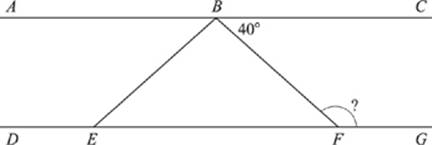
A. 40°
B. 80°
C. 90°
D. 140°
E. 180°
8. If x = – 3, then x2 – 6x – 18 = ?
F. 9
G. 0
H. –9
J. –27
K. –45
9. What is the value of |1 – a| if a = 12?
A. –13
B. –11
C. 11
D. 12
E. 13
10. If ab = c, c = kb, and bc ≠0, then k = ?
F. 1
G. 1/a
H. a – 1
J. a
K. a + 1
11. (x3)13 is equivalent to:
A. x39
B. x16
C. 3x10
D. 3x13
E. 3x16
12. If ![]() what is the largest possible value for x?
what is the largest possible value for x?
F. ![]()
G. 7
H. 14
J. 15
K. 28
13. A circle with a circumference of 46π is divided evenly into 12 sectors. Wha t is the total measure, in degrees, of 5 sectors?
A. 46°
B. 60°
C. 115°
D. 150°
E. 230°
14. Every day at 7:30 A.M. during one school week, Rachel and Ross counted the number of students who entered the school through the main entrance and recorded the results in the table below. For that school week, what was the average number of students who entered the school through the main entrance?
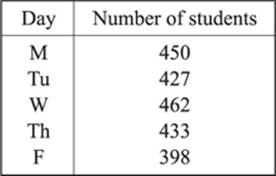
F. 427
G. 434
H. 448
J. 453
K. 462
15. Which of the following equations has both x = – 3 and x = 6 as solutions?
A. (x – 6)(x + 3) = 0
B. (x + 6)(x + 3) = 0
C. (x + 6)(x – 3) = 0
D. (x – 6)(x – 3) = 0
E. x – 6 = x + 3
16. For all x, 7 – 2(x – 10) = ?
F. 5x + 27
G. 5x – 27
H. –2x + 27
J. –2x – 13
K. –2x + 3
17. If 60% of x equals 90, then x = ?
A. 5.4
B. 15
C. 54
D. 150
E. 1,500
18. The price of 1 box of popcorn and 1 drink together is $5.10. The price of 2 boxes of popcorn and 1 drink together is $8.35. What is the cost of 1 drink?
F. $0.75
G. $1.85
H. $2.15
J. $2.55
K. $3.25
19. You are standing in line at the cash register to pay for 2 lamps priced at $8.99 each. A sales tax of 7% of the cost of the lamps will be added (rounded to the nearest cent) to the price of the 2 lamps. You have 20 one-dollar bills. How much will you need in coins if you want to have exact change ready?
A. $0.24
B. $0.38
C. $0.62
D. $0.76
E. $0.87
20. If r3 = 343, then 3r = ?
F. 7
G. 21
H. 49
J. 114
K. 2,229
21. What is the correct order of π, ![]() , and
, and ![]() from least to greatest?
from least to greatest?
A. ![]()
B. ![]()
C. ![]()
D. ![]()
E. ![]()
22. What number can you add to the numerator and denominator of ![]() to get
to get ![]()
F. –3
G. ![]()
H. ![]()
J. 3
K. 6
23. In the standard (x,y) coordinate plane, what is the slope of the line joining the points (5,4) and (2,–7)?
A. 9
B. ![]()
C. 1
D. ![]()
E. ![]()
24. If p is the greatest prime factor of 38 and f is the greatest prime factor of 100, then p + f=?
F. 7
G. 12
H. 24
J. 29
K. 44
25. If (t + v)2 = 289 and tv = 30, then t2 + v2 = ?
A. –11
B. 1
C. 11
D. 61
E. 229
26. If, for all x, (x3α + 5)4 = x44, then α=?
F. 1
G. 2
H. ![]()
J. ![]()
K. 5
27. Which of the following is a value of x that satisfies logx l6 = 2?
A. 2
B. 4
C. 8
D. 16
E. 32
28. One endpoint of a line segment in the (x,y) coordinate plane has coordinates (–2,9). The midpoint of the segment has coordinates (4,4). What are the coordinates of the other endpoint of the segment?
F. (–8,13)
G. (–6,5)
H. (2,13)
J. (10,–1)
K. (–8,36)
29. In the (x,y) coordinate plane, what is the radius of the circle (x – 4)2+(y – 1)2 = 14?
A. 7
B. 14
C. ![]()
D. ![]()
E. 296
30. In the right triangle shown below, cos ∠ A = ?
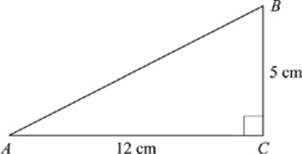
F. ![]()
G. ![]()
H. ![]()
J. ![]()
K. ![]()
31. For all nonzero a and b, ![]()
A. 26a3b14
B. –26a3b3
C. ![]()
D. –26a4b9
E. ![]()
32. Which of the following set of three numbers could be the side lengths, in feet, of a right isosceles triangle?
F. 1, 2, 3
G. 2, 2, 2
H. 2, 2![]() , 4
, 4
J. 1, 2, 2![]()
K. 2, 2, 2![]()
33. In the standard (x,y) coordinate plane, at what point does the line given by the equation 3x + 7y – 2 = 0 cross the y-axis?
A. ![]()
B. 0
C. ![]()
D. 2
E. 3
34. Which of the following logical statements identifies the same set as the graph shown below?
![]()
F. x ≥ –4 and x<6
G. x > –4 and x<6
H. x ≥ –4 or x<6
J. x ≤ – 4 and x>6
K. x ≤ –4 or x>6
35. What is the perimeter of the figure shown below?
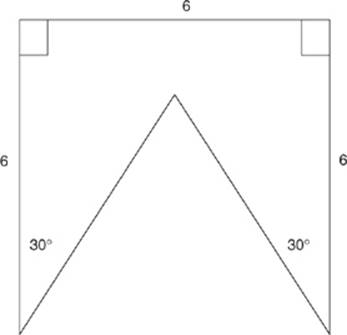
A. 36
B. 30
C. 28
D. 25
E. 24
36. If x and y are real and ![]() then what must be true of the values of x and y?
then what must be true of the values of x and y?
F. x and y must both be negative
G. x and y must both be positive
H. x and y must both be positive or both be negative
J. x and y must have opposite signs
K. x and y may have any value
37. For all pairs of real numbers A and S where A = 2S + 9, S = ?
A. ![]()
B. ![]()
C. 9A – 2
D. ![]()
E. ![]()
38. What is the slope of any line perpendicular to the y-axis in the (x,y) coordinate plane?
F. –1
G. 0
H. 1
J. Undefined
K. Cannot be determined from the given information
39. In the (x,y) coordinate plane, the line with equation 5y = 25x–50 crosses the x-axis at the point with coordinates (a,b). What is the value of a?
A. –10
B. –2
C. 0
D. 2
E. 5
40. A right triangle has side lengths as shown below. What is (tan α)(cos β)?
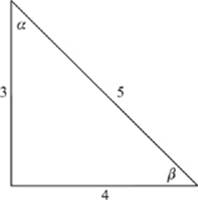
F. ![]()
G. ![]()
H. ![]()
J. ![]()
K. ![]()
41. Amy can run 3 miles in s minutes. At that pace, how many miles can she run in 50 minutes?
A. ![]()
B. ![]()
C. ![]()
D. 3(50s)
E. ![]()
42. An oil tank contains 4,800 gallons of oil. Each gallon of oil weighs approximately 6 pounds. About how many pounds does the oil in the tank weigh?
F. 800
G. 4,806
H. 6,000
J. 28,800
K. 46,800
43. In triangle ABC, the measure of ∠A is 30° and the measure of ∠B is 60°. If ![]() is 16 units long, what is the area, in square units, of triangle ABC?
is 16 units long, what is the area, in square units, of triangle ABC?
A. 16
B. 16![]()
C. 32![]()
D. 256
E. 256![]()
44. In the standard (x,y) coordinate plane, which of the following lines goes through (0,3) and is perpendicular to y = 2x + 1?
F. y = –1/2x + 3
G. y = 1/2x + 3
H. y = 2x + 4
J. y = 3x + 1
K. y = 3x + 2
45. A certain rectangle is 2 times as long as it is wide. Suppose the length is tripled and the width is doubled. The area of the second rectangle is how many times as large as the area of the first?
A. 2
B. 3
C. 6
D. 9
E. 12
46. For what value of z would the following system of equations have an infinite number of solutions?
24x – 15y = 108
72x – 45y = 9z
F. 3
G. 9
H. 12
J. 36
K. 108
47. How many prime numbers are there between 36 and 54?
A. 4
B. 5
C. 6
D. 7
E. 8
48. If tan A = ![]() , x > 0, y > 0, and 0 < A < 90 °, what is sin A?
, x > 0, y > 0, and 0 < A < 90 °, what is sin A?
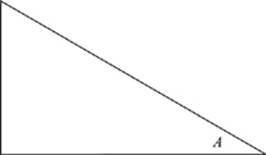
F. ![]()
G. ![]()
H. ![]()
J. ![]()
K. ![]()
49. Aishah will create a circle graph to show how she spends her time during a 24-hour day. The size of the sector representing each activity is proportional to the time spent on that activity. Among other activities, Aishah plays the piano for 1.5 hours. How many degrees should the central angle measure in the sector representing playing the piano?
A. 15
B. 22.5
C. 31
D. 48.3
E. 240
50. Points A, B, and C lie on the same line. If the length of ![]() is 9 meters and the length of
is 9 meters and the length of ![]() is 11 meters, then what are all the possible lengths, in meters, for
is 11 meters, then what are all the possible lengths, in meters, for ![]() ?
?
F. 20 only
G. 2 only
H. 2 and 20 only
J. Any number less than 2 or greater than 20
K. Any number greater than 20 or less than 2
51. In the figure shown below, MN is the arc of a circle with center L. If the length of arc MN is 6π, what is the area of sector LMN?
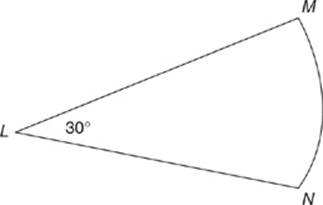
A. 9π
B. 36π
C. 54π
D. 72π
E. 108π
52. If 6a5b7 < 0, then which of the following must be true?
F. a > 0 and b > 0 or a < 0 and b < 0
G. a > 0 and b < 0 or a < 0 and b > 0
H. a = b
J. a < 0 and b < 0
K. a > b
53. Mandy visited 7 patients on her first day as a nurse. Her goal was to visit 3 more patients on each successive day than she had visited the day before. If Mandy met, but did not exceed her goal, how many patients did she visit in all during her first 5 days as a nurse?
A. 19
B. 35
C. 65
D. 105
E. 325
54. What is the smallest possible value for the product of 2 real numbers that differ by 8?
F. 8
G. 6
H. –2
J. –4
K. –16
55. If 0° ≤ x < 90° and cos ![]() then sin x=?
then sin x=?
A. ![]()
B. ![]()
C. ![]()
D. ![]()
E. ![]()
56. For every dollar decrease in price of a set of books, the bookstore sells 1,200 more sets of books per month. The bookstore normally sells 1,750 sets of books per month at $9.50 per set of books. Which of the following expressions represents the number of sets of books sold per month if the cost is reduced by x dollars per set of books?
F. 1,750 + 1,200x
G. 1,750 – 1,200x
H. (9.50 – x)(1,750 + 1,200x)
J. 9.50 + 1,200x
K. 1,750 + 9.50x
57. In a game, 45 marbles numbered 00 through 44 are placed in a box. A player draws 1 marble at random from the box. Without replacing the first marble, the player draws a second marble at random. If the numbers on both marbles drawn have a sum greater than 45 (that is, the sum of Marble 1 and Marble 2 exceeds 45), the player is a winner. If the first marble Martin draws is numbered 17, what is the probability that Martin will be a winner on the next draw?
A. ![]()
B. ![]()
C. ![]()
D. ![]()
E. ![]()
58. In the figure below, all of the line segments are either horizontal or vertical, as shown, and the dimensions are given in centimeters. What is the perimeter, in centimeters, of the figure?
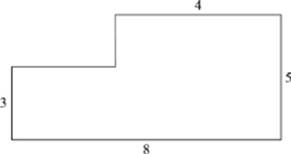
F. 26
G. 29
H. 31
J. 32
K. 81
59. In the standard (x,y) coordinate plane, the vertices of a square have coordinates (0,4), (4,4), (4,0), and (0,0). Which of the following is an equation of a circle that is inscribed in the square?
A. (x + 2)2 + (y + 2)2 = 2
B. (x – 2)2 + (y – 2)2=2
C. (x – 2)2 + (y – 2)2 = 4
D. (x + 2)2 + (y – 2)2 = 4
E. (x + 2)2 + (y + 2)2 = 8
60. On Monday, a skirt was priced at $60.00. On Wednesday, the price was reduced by 15%. Two weeks later, the price was further reduced by 20%. What percent of the original price is this last price?
F. 35%
G. 40%
H. 51%
J. 65%
K. 68%
END OF THE MATHEMATICS TEST
STOP! IF YOU HAVE TIME LEFT OVER, CHECK YOUR WORK ON THIS SECTION ONLY.
![]()
READING TEST
35 Minutes – 40 Questions
DIRECTIONS: This test includes four passages, each followed by 10 questions. Read the passages and choose the best answer to each question. After you have selected your answer, fill in the corresponding bubble on your answer sheet. You should refer to the passages as often as necessary when answering the questions.
PASSAGE I
PROSE FICTION: This passage is adapted from “The Awakening,” by Kate Chopin, originally published in 1899.
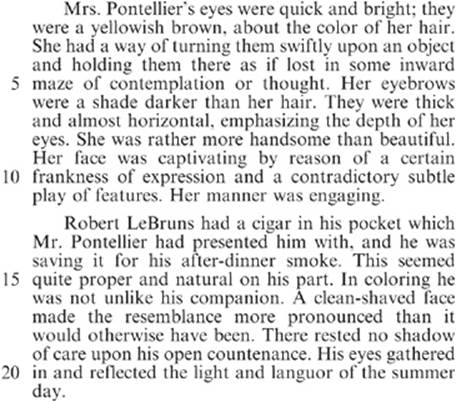
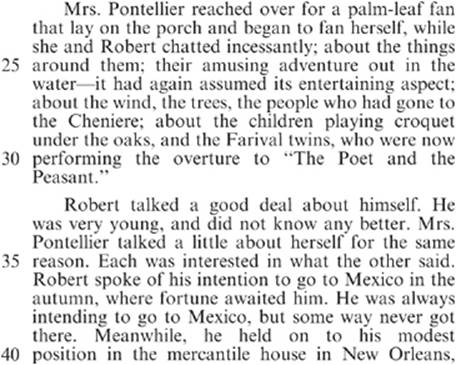
1. When Mrs. Pontellier says “I see Leonce isn’t coming back,” (lines 64–65) she is expressing her belief that:
A. she will be having dinner without her husband.
B. Robert knew her husband wasn’t returning.
C. her husband has left her.
D. she must go to Klein’s for dinner.
2. It can reasonably be inferred from their conversation that Mrs. Pontellier and Robert are:
F. related to each other.
G. each married to someone else.
H. about the same age.
J. long-time friends.
3. The idea that Robert aspires to gain more wealth and social stature than he currently has is best exemplified by which of the following quotations from the passage?
A. “… where fortune awaited him.”
B. “… the young man descended the steps and strolled over toward the croquet players …”
C. “… gave him no small value as a clerk and correspondent.”
D. “Robert talked a good deal about himself.”
4. As it is used in paragraph 3, “She and Robert chatted incessantly” most nearly means that:
F. they each talked about themselves.
G. they had a long and lively conversation.
H. they weren’t listening to each other.
J. they both spoke in loud voices.
5. The passage makes it clear that Mrs. Pontellier and her husband:
A. never spend time together.
B. do not get along.
C. enjoy Robert’s company.
D. have children.
6. As it is used to describe Robert in Paragraph 2, the phrase “There rested no shadow of care upon his open countenance” most nearly means that:
F. his face was well lit.
G. he was relaxed and carefree.
H. he was light-skinned.
J. he was feeling stressed.
7. We may reasonably infer from details in the passage that all of the characters in the story are:
A. poor.
B. sociable.
C. kind.
D. generous.
8. Paragraph 4 indicates that Robert’s ambitions are largely:
F. unfulfilled.
G. satisfactory.
H. mundane.
J. unprecedented.
9. It can be reasonably inferred from information in the passage that:
A. Robert’s mother was better off financially in an earlier time.
B. Robert is visiting his mother to help her out.
C. Robert will never go to Mexico.
D. Robert pretends to be more well-off than he is.
10. Details in the passage suggest that Mrs. Pontellier:
F. longs to go back to her family home.
G. feels like a stranger at Grand Isle.
H. does not enjoy being a wife and mother.
J. is accustomed to being without her husband.
PASSAGE II
SOCIAL SCIENCE: Whales in Inuit Life

11. According to the passage, the traditional Inuit diet includes all of the following EXCEPT:
A. mikigaq.
B. baleen.
C. maktaaq.
D. caribou.
12. It’s clear from the passage that when imposing the moratorium on whaling, the International Whaling Committee:
F. was overwhelmed with support from the entire whaling community.
G. may not have fully considered the impact such a ruling would have on the Inuit.
H. was appalled by the Inuit’s desire to continue hunting whales to extinction.
J. made the decision based on hundreds of years of scientific research.
13. According to the information presented in the passage, which of the following best describes the relationship between the Inuit and whales?
A. The Inuit have hunted whales to the point of near extinction.
B. The Inuit feel that whale hunting is a crime perpetrated by Westerners.
C. The Inuit worship whales.
D. The Inuit consider the whales a gift over which they are very protective.
14. According to the passage, whale meat is nutritionally high in all of the following EXCEPT:
F. phosphorus.
G. niacin.
H. riboflavin.
J. vitamin E.
15. As it is used in the passage (line 8), the word moratorium most nearly means:
A. a funeral home.
B. a common phrase.
C. a suspension of activity.
D. the relative incidence of disease.
16. As it is depicted in the passage, Naluqatak can best be described as:
F. a harvest feast.
G. a pagan celebration.
H. a whale delicacy.
J. a solemn ceremony.
17. It can be inferred that the word coordinated, as it is used in line 62, primarily refers to:
A. matching in design, color, and/or texture.
B. a set of numbers used in specifying a location.
C. moving together in a smooth, organized way.
D. athletic and graceful.
18. It can be inferred from the passage that the Inuit perspective toward the elderly is one of:
F. respect.
G. pity.
H. apathy.
J. condescension.
19. According to the passage, some whalers stop hunting at the end of May because:
A. that is when the calving females are passing through.
B. that is when the hunting season officially ends.
C. they don’t want to miss Naluqatak.
D. they have killed their quota of whales by then.
20. It can be inferred from the passage that, in addition to whales, the Inuit also hunt:
F. penguins.
G. fox.
H. moose.
J. seals.
PASSAGE III
HUMANITIES: “Bobby” Jones: Golf Prodigy
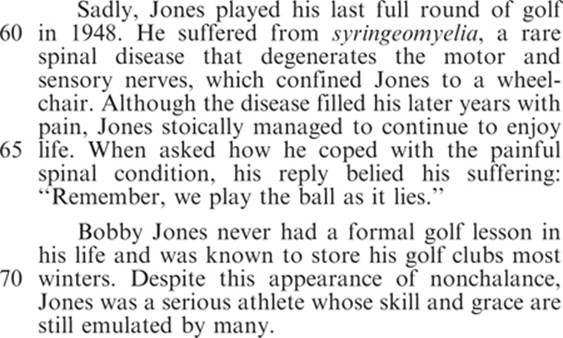
21. The passage suggests that Tiger Woods, when compared to Bobby Jones, is:
A. a poor imitation.
B. similar in many ways.
C. a more talented athlete.
D. eighty years older.
22. It can reasonably be inferred from the second paragraph that “Pop” Keeler could be called:
F. the first sports psychologist.
G. a controlling and manipulative man.
H. a swindler and a crook.
J. a positive force in Jones’ life.
23. The passage primarily emphasizes the idea that Jones’ golfing success was:
A. the only thing that mattered in his life.
B. the result of extensive lessons.
C. only one highlight of a life well lived.
D. due to constant practice.
24. Within the passage, the main function of the first paragraph is to:
F. provide vivid sensory details about the game of golf.
G. explain how Tiger Woods and Bobby Jones met.
H. identify the book that lists many well-known athletes.
J. introduce a comparison between two young golfers.
25. It can be inferred from the passage that Jones’ perspective on higher education was that it:
A. was important to a well-rounded life.
B. was really difficult.
C. was just a way to play more sports.
D. was entirely unnecessary.
26. In the context of the passage, “You might as well praise me for not breaking into banks” (lines 35–36) suggests that Jones:
F. had committed a felony in his temperamental youth.
G. felt the rules of golf were as unbendable as laws against crime.
H. hated to receive praise.
J. thought his admirers were foolish.
27. The passage implies that compared to today’s professional athletes, Bobby Jones’ commitment to being involved in his sport was:
A. dependent on the sport.
B. about the same.
C. lesser.
D. greater.
28. According to the passage, syringeomyelia:
F. occurs most often among golfers.
G. forced Jones to retire at an early age.
H. gradually left Jones incapacitated.
J. involves many needles and injections.
29. When Jones commented about playing “the ball where it lies,” (line 67) he was referring to:
A. his penalty stroke at the 1925 U.S. Open.
B. his debilitating disease.
C. a fundamental rule of golf.
D. being honest.
30. Based on the overall tone of the passage, it can be inferred that the author’s opinion of Jones is one of:
F. admiration and respect.
G. aloof observation.
H. utter disdain.
J. apathy and remorse.
PASSAGE IV
NATURAL SCIENCE: The following passages were adapted from essays regarding manned versus unmanned space missions.
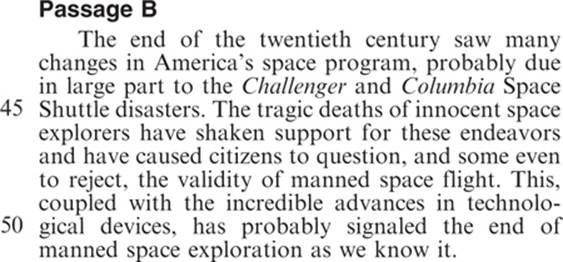
Questions 31 – 33 ask about Passage A.
31. In line 2, the author of Passage A uses the word “certainly” to indicate:
A. knowledge about a specific topic.
B. an opinion over a factual statement.
C. a rebuttal to the previous statement.
D. assurance that the statement is accurate.
32. As it is used in line 17, “calibrating” most nearly means:
F. orbiting.
G. collecting.
H. operating.
J. adjusting.
33. It can be inferred from the passage that the author of Passage A includes the last sentence (”Some even … Earth.”) in order to suggest that:
A. manned space flight is creating a difficult living situation for most humans.
B. Earth’s population growth will increase exponentially because of continued space exploration.
C. Earth’s population is growing to such an extent that the planet might no longer be able to accommodate all of the humans.
D. scientists are unable to account for the public’s reluctance to embrace unmanned space technology, despite the population explosion.
Questions 34 – 37 ask about Passage B.
34. The author of Passage B mentions the space shuttle disasters most likely to:
F. promote the idea of continued space exploration.
G. deny the problems associated with unmanned space exploration.
H. dismiss the fears held by the public regarding space exploration.
J. emphasize the serious ramifications of manned space exploration.
35. As it is used in line 52, “lament” most nearly means:
A. regret.
B. decide.
C. oppose.
D. support.
36. The author of Passage B uses the phrase “computer-driven hunk of metal” (line 76) in order to:
F. decry the value of machines in space missions.
G. highlight the lower risk of unmanned space flight.
H. question hastily prepared unmanned space missions.
J. foster debate over the role of machines in manned space missions.
37. The question at the end of Passage B primarily draws attention to:
A. the beauty of life on other planets.
B. the growing limitations of life on Earth.
C. the hazards involved with manned space travel.
D. the knowledge that can be obtained by continuing space exploration.
Questions 38 – 40 ask about both passages.
38. Both passages base their arguments on the assumption that:
F. technology is the way of the future.
G. humans and technology are on a collision course.
H. interest in potential life beyond Earth will continue.
J. humans have already conquered the “great frontier.”
39. What aspect of manned space flight seems to matter a great deal in Passage A, but not in Passage B?
A. Its marred safety record
B. Its requirement of life-sustaining provisions like food and water
C. Its compatibility with sensitive instruments and large amounts of data
D. Its powerful images showing intrepid explorers expanding human frontiers
40. The authors of both passages agree that:
F. manned space flight is a thing of the past.
G. space exploration will continue in some form.
H. robotics are not reliable enough to be used in the space program.
J. the government is not doing enough to keep the space program going.
END OF THE READING TEST
STOP! IF YOU HAVE TIME LEFT OVER, CHECK YOUR WORK ON THIS SECTION ONLY.
![]()
SCIENCE TEST
35 Minutes – 40 Questions
DIRECTIONS: This test includes seven passages, each followed by several questions. Read the passages and choose the best answer to each question. After you have selected your answer, fill in the corresponding bubble on your answer sheet. You should refer to the passages as often as necessary when answering the questions.
PASSAGE I
Several scientists considered the different environmental factors and their influence on the growth of certain bacteria. The following experiments used E. coli bacteria and a controlled temperature to measure the effect of pH levels, nutrients, and growth factors on the number of bacteria produced within a given time period.
Experiment 1
An E. coli bacterial colony was placed in each of three petri dishes containing the same nutrient concentration. The pH level of each nutrient concentration was varied according to Table 1. The lids of the petri dishes were replaced and the dishes were left alone. After 6 hours, the percent growth of E. coli bacteria was recorded (Table 1).
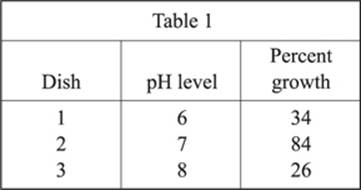
Experiment 2
An E. coli bacterial colony was placed in each of three petri dishes containing different nutrient concentrations in the form of sugar compounds. The lids of the petri dishes were replaced and the dishes were left alone. After 6 hours, the percent growth of E. coli bacteria was recorded (Table 2).
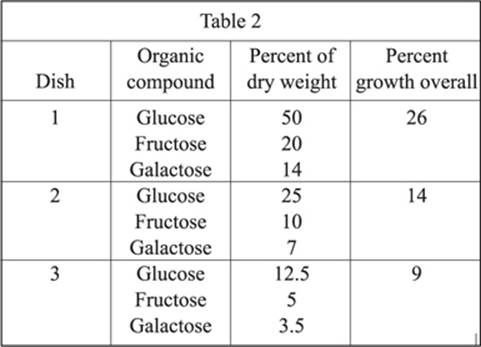
Experiment 3
An E. coli bacterial colony was placed in each of three petri dishes with one of three growth factors. Most bacteria, unlike E. coli, have two requirements for reproduction: growth factors to synthesize nucleic acids and proteins, and small amounts of different vitamins. Experiment 3 was conducted to ensure that the three growth factors had minimal to no effect on growth. The lids of the petri dishes were replaced and the dishes were left alone. After 6 hours, the percent growth of E. coli bacteria was recorded (Table 3).
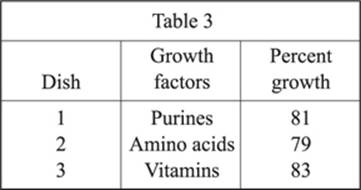
1. According to Table 1, what might best contribute to the growth of E. coli bacteria?
A. A pH level above 8
B. A pH level below 6
C. A pH level near 7
D. A pH level above 7
2. According to the results of the 3 experiments, E. coli bacteria is different from most bacteria in that:
F. it does not require growth factors to reproduce.
G. it does not reproduce if a light source is present.
H. it does not reproduce if amino acids are not available.
J. it requires a specific nutrient concentration to reproduce.
3. Which of the following conclusions is strengthened by the results of Experiment 1?
A. E. coli bacteria reproduce most efficiently at a pH level of 7.
B. E. coli bacteria cannot reproduce at a pH level below 8.
C. E. coli bacteria cannot reproduce at a pH level above 6.
D. E. coli bacteria can only reproduce if the pH level is near 7.
4. Bacteria will often reproduce until all of the nutrients available have been depleted. How could the experiment be altered to maximize the length of time that bacteria will reproduce?
F. Change the observation time from 6 hours to 12 hours.
G. Regularly resupply each group of bacteria with unlimited nutrients.
H. Increase the rate of growth by decreasing the pH levels.
J. Do not test the effect of different nutrient combinations on growth.
5. Which of the following statements is most likely true based on the results of Experiment 2?
A. Lower levels of nutrient concentrations result in a higher growth percentage of E. coli.
B. Higher levels of nutrient concentrations result in a lower growth percentage of E. coli.
C. Higher levels of nutrient concentrations result in a higher growth percentage of E. coli.
D. Nutrient concentration has no effect on the growth percentage of E. coli.
6. The experiments recorded the percent growth that occurred after a 6-hour period. Bacteria often reproduce at a rate that drastically varies from one stage to the next. The best way to study the different stages of growth would be to record the percent growth:
F. after 2 hours only.
G. after 4 hours, then again after 6 hours.
H. after 8 hours only.
J. every 15 minutes for 3 hours.
PASSAGE II
The San Francisco Bay Area in California has several fault lines that extend throughout the entire region. The Loma Prieta, the Bay Area’s last major earthquake, occurred in 1989 along the San Andreas Fault. The Loma Prieta was centered in a mountainous region that was not heavily populated, unlike San Francisco, which lies only 50 miles south. Experts believe that accurate predictions will allow people in populated areas to take the necessary precautions to minimize earthquake damage. Two scientists discuss the probability of the next major earthquake powerful enough to cause widespread damage in the Bay Area.
Scientist 1
The probability of an earthquake occurring in a heavily populated area is extremely difficult to predict. After the massive earthquake of 1906, the rate of powerful, damaging earthquakes in the Bay Area dropped considerably, even though the area is covered with major fault lines. The probability of an earthquake is determined by considering two activities: tectonic plate motions of the Earth’s outer shell and the pressure that is released during an earthquake. Global Positioning Systems (GPS) allow scientists to determine the amount of plate motion and the strain it loads onto faults, the first element of predicting quakes easily and with much certainty. The amount of strain, or pressure released, however, is much more difficult to estimate. Scientists currently inspect trenches, analyze data from seismo-grams, and use historical data to estimate the amount of strain that is released during an earthquake. The main problem is that historical accounts only date back to the 1900s, hardly long enough to illustrate a clear picture of quake activities. Therefore, predictions of the location and the magnitude of an earthquake cannot be made accurately.
Scientist 2
There is a high probability that a major quake will take place within the next 25 years in the Bay Area. Experts can forecast the location and magnitude of an earthquake with a compelling amount of certainty. The probability of an earthquake increases if the strain from plate motion outweighs the amount of pressure released during an actual earthquake. This analysis is complemented with findings from fault line research. The length of fault line ruptures and trenches speak volumes on the magnitude and fault slip of future earthquakes. The 1906 earthquake released over 25 feet of slip, enough to lessen strain in the entire area, thus reducing the frequency and intensity of earthquakes. Because of plate motion, however, strain has been slowly building up. At some point, the equation must balance out again. The only time fault strain is released is during an earthquake, and many populated areas in the Bay Area are near, or even sandwiched between, numerous major fault lines. A damaging earthquake in the near future is inevitable.
7. Which of the following best illustrates the major difference between the two scientists’ opinions?
A. The magnitude of the next earthquake
B. The location of the next earthquake
C. The fault line that will erupt
D. The ability to predict the next earthquake
8. According to Scientist 1, when the probability of an earthquake is calculated, determining the amount of strain released, as compared to determining the strain loaded onto faults from plate motion is:
F. just as difficult.
G. more difficult.
H. slightly less difficult.
J. virtually impossible.
9. The opinion of Scientist 2 suggests that the strain on a fault increases when:
A. more pressure is released.
B. fault slip decreases.
C. plates shift over time.
D. the magnitude increases.
10. According to Scientist 1, which of the following statements best illustrates why an earthquake cannot be accurately predicted?
F. The amount of tectonic plate motion has no influence on the amount of strain put on fault lines.
G. The amount of strain released during earthquakes has not been recorded for a long enough period of time.
H. No system is capable of tracking plate motion to an acceptable degree for predicting earthquakes.
J. No system is capable of measuring the magnitude of an earthquake.
11. A handful of small earthquakes has been recorded in various mountainous regions during the past year. According to Scientist 2, the probability of a large earthquake occurring in those regions would:
A. decrease because some of the strain was released.
B. decrease because plate motion ceased.
C. increase because fault slip would outweigh the strain.
D. increase because strain has not built up.
12. With which of the following statements would both scientists most likely agree? The San Francisco Bay Area:
F. is not in danger of the possibility of an earthquake.
G. is not populated enough to worry about predicting the next earthquake.
H. has a higher chance of experiencing an earthquake than any other area.
J. has fault lines extending throughout the entire region.
13. The argument made by Scientist 2 would be strengthened by which of the following statements about earthquakes, if true?
A. A team of scientists in Ecuador predicts the occurrence of an earthquake near the coast that occurs within days of the date they estimated.
B. A scientist in Alaska announces that the last century’s earthquake records are inaccurate and not applicable for current research.
C. An earthquake occurs in the eastern Mediterranean Sea at a depth of 4.1 kilometers and a magnitude of 5.8.
D. The latest statistics show that the population of Oakland, Calfornia, has been slowly declining for the past 12 years.
PASSAGE III
A series of experiments performed by the Italian scientist Alessandro Volta disproved an earlier theory by Luigi Galvani that an electric current was dependent on the presence of animal tissue. Volta also discovered the means of converting chemical energy into electric energy, which is the basis for the modern battery.
Volta’s research built from the earlier work of Luigi Galvani, who discovered galvanism, a direct electric current produced by chemical reactions. Galvani discovered this phenomenon when he stuck a copper hook through a dead frog and touched the frog’s leg with a piece of iron. The dead frog’s leg jerked as if it were alive. Galvani believed that an electric fluid present in animal tissue created this movement. Volta used the following experiments to disprove Galvani’s theory that an electric fluid was creating the electric current.
Experiment 1
Volta experimented by putting two different metals on his tongue. He experienced pain and concluded that this pain meant that electricity was flowing.
Experiment 2
Volta submerged copper and zinc near each other in an inorganic acidic solution and noted an electrical interaction.
Experiment 3
Volta made a battery cell by placing paper soaked in electrolytes between two different metals and produced a consistent flow of electricity.
Experiment 4
Volta built piles using 30, 40, or 60 layers of metal and separated them with a piece of material dampened by an acid solution. Volta discovered that the intensity of the electric shock was greater when the piles contained 60 layers of metal rather than 30 or 40 layers.
14. Given the results of Experiment 1, which of the following statements best explains why this experiment did not disprove Galvani’s earlier theory involving electric fluid?
F. Galvani used more than 2 metals in his frog experiment to create an electric current.
G. Volta’s tongue is animal tissue and could have contained electric fluid.
H. Galvani’s frog was dead, so it could not feel pain to verify the presence of an electric current.
J. The surface of Volta’s tongue was moist and the dead frog’s leg was not.
15. Which of the following was probably thought to be true in designing Experiment 1?
A. Animal tissue was not needed to produce an electric current.
B. Two metals were sufficient to produce an electric current.
C. Pain was the most accurate way to measure the power of an electric current.
D. A moist surface was not necessary to produce an electric current.
16. The data from this passage best supports the conclusion that:
F. animal tissues do not contain any fluid that can be used to conduct an electric current.
G. only copper and zinc will produce an electric current in inorganic solutions.
H. Galvani did not discover that an electric current is produced by chemical reactions.
J. more than two pieces or layers of metal can be used to produce an electric current.
17. Which of the following hypotheses is best supported by the results in Experiment 4?
A. The larger the number of metal layers piled and separated by material dampened in an acidic solution, the greater the intensity of the electric shock.
B. In order to produce an electric shock, an acidic solution is needed to create the electric current.
C. The intensity of the electric shock is likely to be dependent on the weight of the individual elements used as well as the density of the elements.
D. Certain elements create a greater electric shock when combined than others.
18. To test the hypothesis that an acidic solution is always needed to create an electric current, the researcher should determine:
F. whether the type of acidic solution used in Volta’s experiments is present in a dead frog’s legs.
G. whether the tongue and electrolytes contain an acidic solution.
H. whether all acidic solutions are inorganic in origin.
J. whether copper or zinc respond to different acidic solutions.
19. Which of the four experiments disproved Galvani’s theory that a direct electric current is produced by chemical reactions?
A. Experiments 2, 3, and 4, because they did not involve animal tissue.
B. Experiment 1, because it involved living human tissue.
C. None of the experiments necessarily disprove Galvani’s theory that a direct electric current is produced by chemical reactions.
D. Experiment 3, because Volta created a consistent flow of energy.
PASSAGE IV
A study was conducted to compare the accuracy of two commercially available swimming pool water testing kits (Kit A and Kit B) in determining the levels of chlorine, bromine, and pH in two different water samples. The water samples were kept at a constant temperature of 72°F throughout the entire study. The results include the ideal level or concentration of each chemical and the readings of each kit for two different 100 milliliter (ml) samples of water (Table 1).
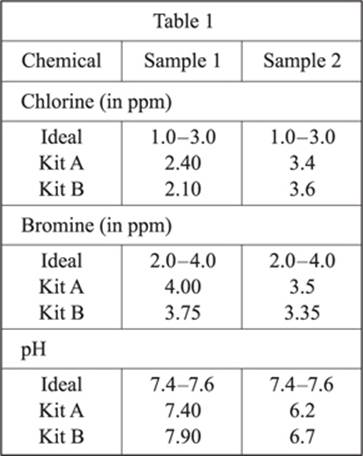
The pH scale measures how acidic or basic a substance is on a scale of 0 to 14. Lower numbers indicate increasing acidity, and higher numbers indicate increasing alkalinity (basicity). The ideal pH of a swimming pool is near 7.5. The minimum and maximum pH for a standard swimming pool are 7.2 and 7.8, respectively. Most residential swimming pools, however, have a tendency to drift toward a pH of 8.
The pH level of a sample of water has a tremendous impact on the effectiveness of chlorine. Chlorine is used to destroy contaminants and, at higher levels, is capable of having a bleaching effect on colors and a corrosive effect on surfaces. pH levels are tested using phenol red, a dark red powder that is added to a sample and will change the color of the water, depending on the pH. The effectiveness of chlorine at different pH is shown in Figure 1, as a percentage of chlorine’s effectiveness at destroying harmful contaminants.
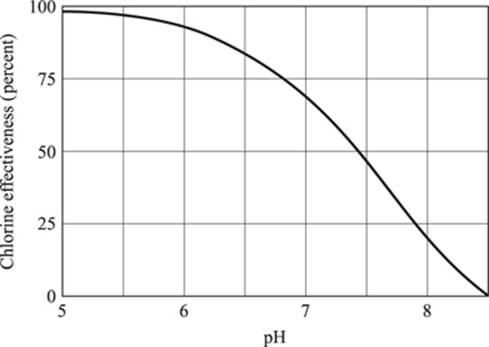
Figure 1
20. Which of the following statements best describes the effectiveness of the chlorine in Sample 2?
F. The concentration of chlorine in Sample 2 is at an ideal level.
G. The concentration of chlorine in Sample 2 may be corrosive to surfaces.
H. The concentration of chlorine in Sample 2 is too weak to destroy contaminants.
J. The Sample 2 reading of chlorine from Kit A was higher than the reading from Kit B.
21. Which of the following statements is best supported by the results of the study?
A. The water in Sample 1 only has ideal levels of both chlorine and bromine.
B. The water in Sample 2 only has ideal levels of both chlorine and bromine.
C. The water in both Sample 1 and Sample 2 has ideal levels of both chlorine and bromine.
D. The water in neither Sample 1 nor Sample 2 has ideal levels of both chlorine and bromine.
22. The readings from Kit A of Sample 1 indicate that:
F. the water from Sample 1 is probably balanced and safe.
G. the water from Sample 1 is probably harmful to swimmers.
H. bromine levels are difficult to accurately measure.
J. Kit B is inferior to Kit A in measuring pH.
23. Another water sample was tested using Kit B. The results indicate that the effectiveness of the chlorine in the sample was just above 80%. What is the estimated pH level of the water sample?
A. 5.0
B. 6.5
C. 7.5
D. 8.0
24. According to Figure 1, as pH increases:
F. the presence of harmful contaminants is most likely low.
G. the presence of harmful contaminants is most likely not affected.
H. the presence of harmful contaminants is most likely high.
J. the presence of harmful contaminants cannot be detected.
PASSAGE V
The human body involves a system of many complex processes. For example, it has a specific process for meeting the energy demands of working muscles during exercise. The process by which food molecules (glucose) are broken down in the muscle cells to release energy for work is called cellular respiration. There are two types of cellular respiration: aerobic (requires oxygen) and anaerobic (does not require oxygen).
When the muscles are working, the body turns adenosine diphosphate (ADP) into adenosine triphosphate (ATP). ATP is then used as a source of energy, a requirement of muscle contraction. (ATP production is measured in moles, a specific unit of measurement.) Figure 1 shows the activity of the two biochemical processes that provide ATP as a function of the intensity of a workout.
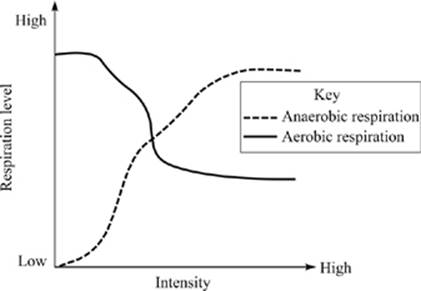
Figure 1
Aerobic respiration produces 18 times more ATP per glucose molecule than does anaerobic respiration. However, the process requires plenty of oxygen and is much more time consuming. Although anaerobic respiration is far less efficient, it is the fastest way to generate ATP. Table 1 shows the sources of glucose that are used during both types of respiration.
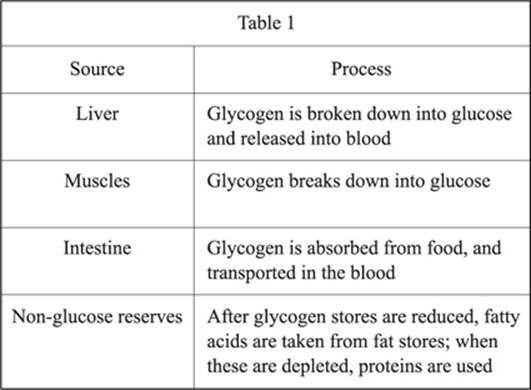
An individual’s fitness level can be determined by measuring the maximum amount of oxygen that can be used in 1 minute of activity per kilogram of body weight, also known as VO2 max. Figure 2 shows the milliliters of oxygen that can be consumed in 1 minute per kilogram of body weight for both females and males at “Poor” and “Excellent” fitness levels.

Figure 2
25. According to Figure 1, as a person’s workout intensity increases:
A. aerobic respiration only increases.
B. aerobic respiration decreases, then increases sharply.
C. anaerobic respiration increases, then levels off.
D. anaerobic respiration decreases, then increases sharply.
26. If an athlete’s body produced 2 moles of ATP from anaerobic respiration, how many moles of ATP would have been produced from the same amount of glucose during aerobic respiration?
F. 36
G. 34
H. 18
J. 16
27. According to the passage, once the glucose from stored glycogen is used, where does the body next obtain sources of energy?
A. Small intestine
B. Fat stores
C. Muscles
D. Protein
28. As compared to a 50-year-old male in excellent physical condition, a woman of the same age and fitness level consumes approximately how much less oxygen (in milliliters per minute per kilogram, ml/min/kg, body weight)?
F. 0
G. 12
H. 33
J. 45
29. A 27-year-old female in poor physical condition would consume between:
A. 25 to 30 milliliters of oxygen per minute.
B. 33 to 35 milliliters of oxygen per minute.
C. 37 to 41 milliliters of oxygen per minute.
D. 47 to 52 milliliters of oxygen per minute.
PASSAGE VI
Cholesterol is a soft, waxy compound that is found in many foods and throughout the entire human body. The body’s liver produces cholesterol to form and maintain cell membranes, some hormones, and vitamin D. The liver is also responsible for eliminating cholesterol from the body. Excessive levels of cholesterol in the blood, however, can lead to health problems, including heart disease.
The dietary consumption of specific types of fats is a major factor influencing the levels of low-density lipo-protein cholesterol (LDL), or “bad” cholesterol, and high-density lipoprotein (HDL), or “good” cholesterol. The circulation of too much LDL cholesterol in the blood can lead to buildup in the arteries and subsequently, the development of heart disease. The presence of higher levels of HDL cholesterol helps to protect against the development of heart disease.
Table 1 shows specific types of fats and their effect on cholesterol levels.
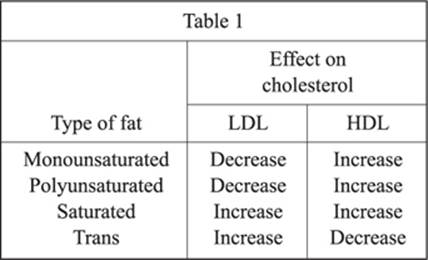
30. Approximately 75% of the cholesterol in the blood is produced in the body. According to the passage, the remaining 25% of cholesterol that can be found in the blood comes from:
F. diet.
G. LDL.
H. genetics.
J. HDL.
31. If HDL protects against the development of heart disease, which of the following statements is most likely to be true?
A. HDL carries cholesterol to the liver where it can be eliminated.
B. HDL dissolves in the bloodstream and increases total cholesterol levels.
C. HDL becomes “bad” cholesterol after it enters the bloodstream.
D. HDL cholesterol cannot be affected by diet or any other risk factor.
32. According to the passage, which type of fat has the greatest negative net effect on cholesterol levels?
F. Monounsaturated fats
G. Polyunsaturated fats
H. Trans fats
J. Saturated fats
33. According to the following table, which type of cooking oil would most likely be suggested for a person with high cholesterol?

A. Coconut oil, because it has the least amount of polyunsaturated fats.
B. Palm oil, because it has a good amount of both mono- and polyunsaturated fats.
C. Canola oil, because it has the least amount of saturated fats and a low amount of polyunsaturated fats.
D. Canola oil, because it has the least amount of saturated fats and the most unsaturated fats.
34. Omega-3 fatty acid (found in fish such as mackerel, salmon, sardines, or swordfish) is known for its potential to lower the risk of heart disease. Which of the following best explains why this statement may be true? Omega-3 fatty acid:
F. is a form of saturated fat that increases the levels of both HDL and LDL in the bloodstream.
G. is a form of monounsaturated fat that lowers the level of HDL and increases the level of LDL.
H. is a form of polyunsaturated fat that lowers the level of HDL and increases the level of LDL.
J. is a form of polyunsaturated fat that lowers the level of LDL and increases the level of HDL.
PASSAGE VII
Friction is the resistive force to motion. If an object is moving in one direction, friction is pulling in the opposite direction, allowing an object to stop moving or stay in place. Friction depends mostly on the smoothness of the surfaces that come into contact with an object and the magnitude of force (or weight) of one object on the other. A rough surface, for example, increases friction, making it more difficult for one object to slide over the other.
Some students conducted three experiments to test their hypotheses about the influence of surface material and speed on the force of friction. The students created a ramp and runway from different-sized blocks and two pieces of plywood (Figure 1). They used a toy car to test the effect of friction on the speed and distance that the car was able to travel, once it reached the flat surface. The same car was used in all of the experiments. The students changed the angle (or height) of the ramp in order to change the speed that the car could travel.
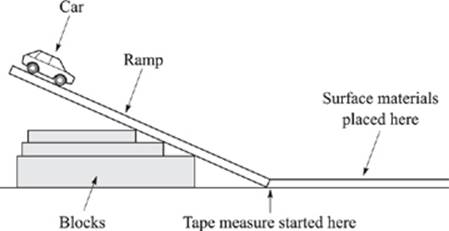
Figure 1
Experiment 1
The ramp in this experiment was placed at a 45° angle. The car was placed at the top of the ramp and released. A tape measure was used to determine the distance that the car traveled once it left the ramp until it stopped on different materials that covered the flat surface at the bottom of the ramp. For each material, the experiment was repeated three times and the results are shown in Table 1.
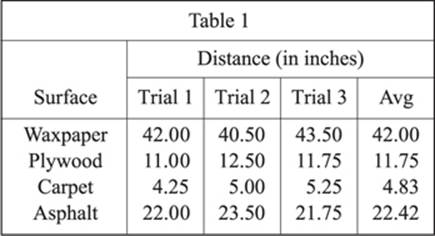
Experiment 2
The experiment was repeated with the ramp placed at a 30° angle. The results are shown in Table 2.
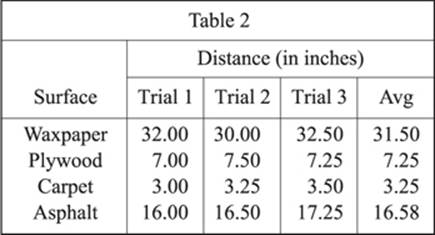
Experiment 3
The experiment was repeated with the ramp placed at a 15° angle. The results are shown in Table 3.
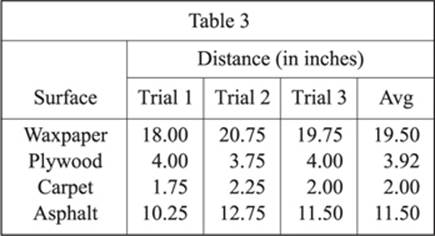
35. In each experiment, the material used affected the force of friction and, as a result, the distance that the car traveled before it came to a stop. Based on the experiments, it is most likely that the stronger the friction, the:
A. heavier the object as compared to the material.
B. lighter the object as compared to the material.
C. longer the distance the car could travel.
D. shorter the distance the car could travel.
36. Using a smoother surface would most likely:
F. both decrease friction and increase the distance traveled before the car came to a stop.
G. both decrease friction and decrease the distance traveled before the car came to a stop.
H. both increase friction and increase the distance traveled before the car came to a stop.
J. both increase friction and decrease the distance traveled before the car came to a stop.
37. If each of the following materials was used, as in the experiments, to cover the flat surface at the bottom of the ramp, the friction exerted will likely be the least with which material?
A. Brick
B. Lace
C. Aluminum foil
D. Window screens
38. Which of the following statements best explains why lubricant or oil is used to decrease the friction between two objects?
F. It increases the magnitude of force on each object, making it harder to slide one object past the other.
G. It smoothes the surfaces of both objects, making it easier for one object to slide past the other.
H. It increases the gravitational pull on the objects, making it harder to slide one object past the other.
J. It decreases the weight of each object, making it easier to slide one object past the other.
39. Which variable was kept constant throughout all the experiments?
A. The mass of the car
B. The speed of the car
C. The surface material
D. The angle of the ramp
40. According to the results of the experiments, increasing the ramp’s height increased the distance that the car could travel, regardless of the material used. Increasing the height of the ramp:
F. both decreased the speed of the car and increased friction.
G. both decreased the speed of the car and decreased friction.
H. both increased the speed of the car and increased the distance traveled before friction could stop it.
J. both increased the speed of the car and decreased the distance traveled before friction could stop it.
END OF THE SCIENCE TEST
STOP! IF YOU HAVE TIME LEFT OVER, CHECK YOUR WORK ON THIS SECTION ONLY.
WRITING TEST
DIRECTIONS: This test is designed to assess your writing skills. You have forty (40) minutes to plan and write an essay based on the stimulus provided. Be sure to take a position on the issue and support your position using logical reasoning and relevant examples. Organize your ideas in a focused and logical way, and use the English language to clearly and effectively express your position.
When you have finished writing, refer to the Scoring Rubrics discussed in Chapter 7 to estimate your score.
Note: On the actual ACT you will receive approximately 2.5 pages of scratch paper on which to develop your essay, and approximately 4 pages of notebook paper on which to write your essay. We recommend that you limit yourself to this number of pages when you write your practice essays.
PLAYING VIDEO GAMES
Once found only in arcades, video games are now a mainstay of at-home entertainment options for teens. In fact, teenagers have become quite adept at playing video games. One interesting development is that, on one hand, video games have been blamed for increasing violent tendencies in teens and, on the other hand, praised for improving problem solving skills in high school students. Given the potential controversy surrounding teenagers' playing of video games, it is worth examining the implications of the prevalence of video games in the daily lives of teenagers.
Perspective One
Exposing young minds to violence, whether real or virtual, can have a negative impact on how young people view and interact with the world. Violent video games can set a precedent for bad behavior as teenagers mature.
Perspective Two
The ability to “think on your feet” and solve problems is put to the test when trying to master a new video game. Teens have a chance to develop this highly transferable skill, which will serve them well in life.
Perspective Three
As video games have become more prevalent, actual real-world violence in society has decreased. Millions of consumers of all ages continue to play violent video games and seem to be able to grasp the difference between the game and reality without becoming violent themselves.
Essay Task
Write a unified, coherent essay in which you evaluate multiple perspectives on the implications of teens playing video games. In your essay, be sure to:
• analyze and evaluate the perspectives given
• state and develop your own perspective on the issue
• explain the relationship between your perspective and those given
Your perspective may be in full agreement with any of the others, in partial agreement, or wholly different. Whatever the case, support your ideas with logical reasoning and detailed, persuasive examples.
![]() ANSWER KEY
ANSWER KEY
English Test
1. A
2. J
3. C
4. H
5. C
6. G
7. B
8. J
9. A
10. F
11. C
12. F
13. C
14. G
15. D
16. H
17. D
18. J
19. A
20. G
21. B
22. H
23. B
24. H
25. D
26. J
27. A
28. H
29. A
30. F
31. C
32. F
33. D
34. J
35. B
36. J
37. D
38. F
39. B
40. J
41. B
42. J
43. C
44. G
45. D
46. G
47. D
48. G
49. B
50. F
51. A
52. F
53. D
54. F
55. D
56. H
57. B
58. F
59. C
60. F
61. A
62. G
63. C
64. G
65. B
66. F
67. B
68. F
69. D
70. F
71. C
72. G
73. C
74. H
75. C
Mathematics Test
1. B
2. G
3. A
4. K
5. C
6. K
7. D
8. F
9. C
10. J
11. A
12. H
13. D
14. G
15. A
16. H
17. D
18. G
19. A
20. G
21. B
22. J
23. B
24. H
25. E
26. G
27. B
28. J
29. D
30. H
31. B
32. K
33. C
34. F
35. B
36. H
37. D
38. G
39. D
40. K
41. E
42. J
43. C
44. F
45. C
46. J
47. B
48. H
49. B
50. H
51. E
52. G
53. C
54. K
55. A
56. F
57. A
58. F
59. C
60. K
Reading Test
1. A
2. H
3. A
4. G
5. D
6. G
7. B
8. F
9. A
10. J
11. B
12. G
13. D
14. H
15. C
16. F
17. C
18. F
19. A
20. J
21. B
22. J
23. C
24. J
25. A
26. G
27. D
28. H
29. B
30. F
31. D
32. J
33. C
34. J
35. A
36. G
37. C
38. H
39. C
40. G
Science Test
1. C
2. F
3. A
4. G
5. C
6. J
7. D
8. G
9. C
10. G
11. A
12. J
13. A
14. G
15. B
16. J
17. A
18. G
19. C
20. G
21. A
22. F
23. B
24. H
25. C
26. F
27. B
28. G
29. A
30. F
31. A
32. H
33. D
34. J
35. D
36. F
37. C
38. G
39. A
40. H
![]() SCORING GUIDE
SCORING GUIDE
Your final reported score is your COMPOSITE SCORE. Your COMPOSITE SCORE is the average of all of your SCALED SCORES.
Your SCALED SCORES for the four multiple-choice sections are derived from the Scoring Worksheet on the next page. Use your RAW SCORE, or the number of questions that you answered correctly for each section, to determine your SCALED SCORE. If you got a RAW SCORE of 60 on the English Test, for example, you correctly answered 60 out of 75 questions.
Step 1 Determine your RAW SCORE for each of the four multiple-choice sections:
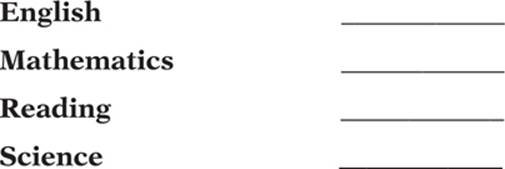
The following Raw Score Table shows the total possible points for each section.
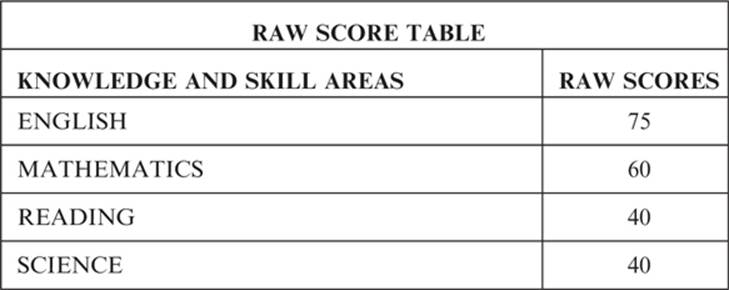
Multiple-Choice Scoring Worksheet
Step 2 Determine your SCALED SCORE for each of the four multiple-choice sections using the following Scoring Worksheet. Each SCALED SCORE should be rounded to the nearest number according to normal rules. For example, 31.2 ≈ 31 and 31.5 ≈ 32. If you answered 61 questions correctly on the English section, for example, your approximate SCALED SCORE would be 29.
If you take the optional Writing Test, you should refer to Chapter 7 for guidelines on scoring your Writing Test Essay.
Step 3 Determine your COMPOSITE SCORE by finding the sum of all your SCALED SCORES for each of the four sections: English, Mathematics, Reading, and Science, and divide by 4 to find the average. Round your COMPOSITE SCORE according to normal rules. For example, 31.2 ≈ 31 and 31.5 ≈ 32.

![]() ANSWERS AND EXPLANATIONS
ANSWERS AND EXPLANATIONS
English Test Explanations
PASSAGE I
1. The best answer is A. Answer choices B, C, and D can be eliminated because of incorrect comma usage. Answer choice B separates the noun result from its complement, the prepositional phrase of ingenuity. Answer choice C separates the preposition of from its object, ingenuity. Answer choice D includes an unnecessary comma after of.
2. The best answer is J. Charles Lindbergh is the logical subject of this sentence and should, therefore, be the grammatical subject. The sentence as written, with the gerund being before Charles Lindbergh, is awkward grammatically and unclear in meaning. Eliminate answer choice F. Answer choice G can be eliminated because it uses the subject pronoun he when Charles Lindbergh already serves that purpose. Finally, answer choice H can be eliminated because the relative pronoun which and the verb was would be highly awkward in this position in the sentence.
3. The best answer is C. Neither of the introductory prepositional phrases In 1918 and with the United States in the throes of World War I contains a verb, so the main clause begins after these phrases set apart by a comma. Eliminate answer choice B. Answer choices A and D can be eliminated for their awkwardness and wordiness. Answer choice C represents the clearest and most concise answer choice.
4. The best answer is H. In this sentence, Minnesota, although a noun, acts as a modifier of farm, so the two words should appear together. Eliminate answer choice J. Answer choices F and G can be eliminated for their incorrect comma usage. In answer choice F, the prepositional phrase under his care modifies the noun farm, so no comma must intervene between them. Similarly, in answer choice G, the prepositional phrase modifies the verb thrived, so no comma must intervene in this case either.
5. The best answer is C. The verb encouraged needs a subject, so the pronoun they (his parents) should be added. The dependent clause beginning with when is not a complete sentence, and therefore, should be separated only by a comma, not a period or semicolon.
6. The best answer is G. As written, this sentence is incomplete because it lacks a main verb. Eliminate answer choices F, H, and J because they do not provide a main verb. Only answer choice G contains a verb with tense, the simple past verb, resulted.
7. The best answer is B. The phrase in pursuit of a degree is obvious information considering Lindbergh dropped out of college. (You must finish college to earn a degree.) Therefore, eliminate answer choice A. Answer choices C and D are redundant in the same way, and can therefore be eliminated.
8. The best answer is J. No punctuation should separate the gerund performing from its complement as a barnstormer, wing walker, parachutist, and skydiver. Remember that colons and semicolons, in particular, have very specific usages. They should not interrupt the flow of a phrase.
9. The best answer is A. The introductory clause Having found his true passion as a pilot should be joined to the main clause with a comma.
10. The best answer is F. To maintain parallel structure within this sentence, the verb focused should agree in tense with the verb learned. As this is the case, no change is necessary.
11. The best answer is C. This question requires you to choose the most concise answer choice. Although all the answer choices are grammatically correct, answer choice C expresses the meaning in the shortest and clearest way. In addition, using the subject pronoun he is appropriate because Lindbergh’s name is used in the preceding sentence.
12. The best answer is F. Answer choice G can be eliminated because even though requires a clause as a complement (his disinterest in formal education is a noun phrase). Answer choices H and J can be eliminated because they indicate a cause-effect relationship when a contradictory relationship exists. Despite properly indicates the apparent contradiction between disinterest in formal education and enjoyment of learning.
13. The best answer is C. To describe the manner in which Lindbergh displayed an enjoyment of learning throughout his life, the gerund form of the verb is appropriate. Furthermore, the two verbs joined with the conjunction andmust have parallel form. Therefore, only answer choice C is appropriate here.
14. The best answer is G. This question tests your ability to arrange phrases in the clearest order. In this case, the prepositional phrase with surgeon Alexis Carrel best modifies the noun work and not development or perfusion pump. The prepositional phrase should immediately follow what it modifies. Therefore, you can eliminate answer choices F and H. Answer choice J is wordy, awkward, and has incorrect meaning, so it can also be eliminated.
15. The best answer is D. The focus of the passage is on Lindbergh’s intellectual growth and the untraditional ways in which he trained and used his intelligence. Only choice D sums up this message and provides an appropriate conclusion to the essay.
PASSAGE II
16. The best answer is H. The second sentence contains a contrast to what comes before. That is, the first sentence says Vikings were crude; the second appears to contradict that by saying they were advanced. The word howeveris the only choice to signal this contrast.
17. The best answer is D. Because the new sentence would follow an assertion that the Vikings were advanced, the logical choice would contain an example of some sort of accomplishment. Answer choice D is one such accomplishment, and it mirrors the next sentence, which elaborates on the Vikings’ oceangoing superiority compared to other European cultures even centuries later, of which Christopher Columbus was a part.
18. The best answer is J. The adjective seafaring modifies the noun traders, so no comma must come between the two words. Eliminate answer choice F. The colon has very specific usages, and cannot be used in this position between a noun (traders) and a prepositional phrase (with … ships) that modifies it. Eliminate answer choice G. Answer choice H can be eliminated because no comma should separate a preposition (with) from its object (purpose-built, wooden trading ships).
19. The best answer is A. The sentence as it is written is the most concise statement of the information. Therefore, no change is necessary.
20. The best answer is G. The paragraph has a clear topic: Vikings. This sentence is giving more detailed information about the Vikings. Since there has been no change in subject from the previous sentence, and it has already been stated that the Vikings are from Scandinavia, a simple restatement of the antecedent is most clear and concise.
21. The best answer is B. The first step in answering this question is to recognize that you must use the possessive determiner their, not the contraction of they are. Eliminate answer choice D. The phrase “Regardless of whether Vikings arrived first” is not an independent clause. Therefore, it cannot be separated from the rest of the sentence by a semicolon. A colon would be used if what followed were an example or a list. Since it’s not, a comma is the only punctuation necessary.
22. The best answer is H. It is idiomatic to say sailed around, sailed over, sailed across, and sailed on the sea in this context. It is not appropriate to say the Vikings sailed into the sea to obtain goods.
23. The best answer is B. In order to maintain parallel structure, the tense of meet has to match the tense of its paired verb, trade. Here, the author tells you that, in the past, Vikings traded often with Arabs. Since met is the past tense of meet, answer choice B is correct.
24. The best answer is H. Although all the answer choices have at least some merit, only answer choice H suits the rest of the paragraph. Moreover, the next sentence begins: Similar craftsmanship…. Therefore, the underlined portion should speak to the craftsmanship exhibited in Viking sword and ax blades. Answer choice H contains the most specific details about the fineness of the blades.
25. The best answer is D. The phrase beginning Making butter … is not a complete sentence; it lacks a verb with tense. Therefore, you should not use any form of end punctuation before that phrase. It is appropriate to use a comma.
26. The best answer is J. The information included in answer choices F, G, and H is irrelevant. There is no need to further discuss fabrics—it will not add any useful information to the passage.
27. The best answer is A. The subject of this clause is those who could, which means those who could read. It is important to recognize that this whole noun phrase is the subject, and that could does not affect the verb that follows. Because the subject is plural and “receives” the action of the verb consider, the plural passive-voice construction were considered is the best answer.
28. The best answer is H. Like periods, semicolons are used to separate independent clauses. These runes is not an independent clause. Therefore, the semicolon should be removed. These runes is the subject of the sentence and were is the verb. So, no punctuation should come between them.
29. The best answer is A. In order to maintain parallel structure within the paragraph, this verb needs to be in the simple past tense. It also needs to be plural because the subject, runes, is plural. The plural simple past tense of to be is were. Note that the other main verbs are also in the simple past tense: was, were, believed, wrote, and so on.
30. The best answer is F. The information given in answer choice F directly reflects the information provided in the third paragraph. Answer choice G is too vague. Answer choice H contradicts information in the last paragraph (the Vikings wrote down little of their history). Answer choice J is not mentioned in the passage.
PASSAGE III
31. The best answer is C. It is idiomatic in this context to say one of.
32. The best answer is F. The sentence as written is concise and grammatically correct. No change is needed.
33. The best answer is D. The sentence already has a main verb, make. Therefore, additional verbs, like has or is in She’s and It’s, are unnecessary.
34. The best answer is J. If two related independent clauses are linked by a coordinating conjunction (in this case and), a comma is used before the conjunction. The connecting words so and with are not appropriate.
35. The best answer is B. To answer this question correctly, look ahead to the next paragraph to see what direction the essay is going to take. In this case, the author shifts from a description of Kari to a description of the Girls State convention. Answer choice B not only provides an introduction to the idea of Girls State, but it links Kari to it through her participation in the convention. Answer choice B is an effective transitional sentence.
36. The best answer is J. In English idiom, the noun opportunity takes a verb in the infinitive (to + base form) form as its complement (opportunity to eat / dance / sing / participate / etc). It does not take a prepositional phrase as in answer choices F, G, and H.
37. The best answer is D. Answer choices A and C can be eliminated because they would place a comma between the verb phrase was chosen and its complement to be one of her state’s senators. Similarly, answer choice B can be eliminated because the colon cannot interrupt a clause in that way. Besides not having punctuation after chosen, answer choice D is best because it correctly sets apart the interrupting phrase of course from the passive verb construction was chosen using commas.
38. The best answer is F. After the definite determiner the, a singular or plural noun phrase may be used. Together, they form the subject of the verb that comes next. First, answer choices G and H can be eliminated because by omitting a form of be, packed becomes the main verb, which does not make sense. Second, the form of be must agree in number with the subject. Eliminate answer choice J because schedules is plural and was is singular. In answer choice F, schedule and was are both singular.
39. The best answer is B. To describe a completed action in the past (meeting a cadet) that interrupted another action (sightseeing), the appropriate sequence of tenses (in either order) is the simple past, which describes completed events, and the past perfect progressive, which emphasizes the duration of an event that was interrupted in the past. Answer choices A and C do not follow this sequence of tenses and, therefore, make the sentence awkward. Answer choice D has a slight difference in meaning (suggesting that perhaps the meeting was planned), and it is not as concise as answer choice B, so eliminate it.
40. The best answer is J. The sentence has the relative subject pronoun who beginning the relative clause modifying cadet, so it is appropriate to use a comma after cadet. No punctuation should be used between the subject whoand the verb offered, so eliminate answer choice G. Similarly, no punctuation should come between the verb offered and its complement beginning to show; therefore, eliminate answer choices F and H.
41. The best answer is B. Between the similar answer choices A and B, answer choice B is best because the plural verb promise agrees with the plural antecedent people of the relative subject pronoun who. Answer choice C can be eliminated for wordiness. Answer choice D is awkward in structure and meaning, so it can be eliminated.
42. The best answer is J. Roman numeral II is easy to eliminate; words are italicized to emphasize their significance, not insignificance. Therefore, eliminate answer choice H. Roman numeral I is more subtle, but Sentence 5 makes a distinction between what Kari told her friend and what she told the cadet in the other letter. Roman numeral I makes sense, so eliminate answer choice G. The italics indicate that something significant has been communicated. You can assume (and it turns out to be the case) that this information is significant to what comes next, so Roman numeral III also makes sense.
43. The best answer is C. The first half of the paragraph focuses on Kari’s letter to her girlfriend. At Sentence 6, however, the author begins to talk about Kari’s letter to the cadet and his response to what he actually received. This shift in focus marks the most appropriate place to begin a new paragraph.
44. The best answer is G. The main idea of this essay is a description of an extremely popular girl who, every now and again, gets in trouble despite herself. Answer choice G reminds the reader that Kari is very popular, while still acknowledging that not everyone feels positively about her. It also says this in a lighthearted way. The other answer choices don’t sum up the essay and are much more serious in tone.
45. The best answer is D. The essay reflects the author’s personal reminiscence of a cousin, Kari, and includes details about certain events in Kari’s life. While the essay mentions Girls State, it is not the main focus of the essay. Therefore, eliminate the two yes answer choices, A and B. Answer choice C can be eliminated because the passage does indeed show how Girls State provides opportunities to high school juniors. The focus of the passage is the writer’s cousin Kari. Therefore, answer choice D is best.
PASSAGE IV
46. The best answer is G. Commas are used to separate adjectives in a list like this one. However, a comma must not separate the verb be from the predicate. Only answer choice G is correct.
47. The best answer is D. The sentence as it is written lacks a main clause, and thus is incomplete. Answer choice D puts the main idea of the sentence first (“I grew up on a farm in Iowa”). The descriptive clause follows, giving additional information. This order is the most concise and logical of any of the answer choices.
48. The best answer is G. The verb phrase after the comma (and took great pains …) is not an independent clause, meaning it could not stand on its own as a complete sentence. Therefore, a comma should not be used to separate it from the preceding clause.
49. The best answer is B. Answer choices A and D (Therefore and Hence) indicate that the following sentence is a result of what’s come before. In this case, the sentences are not connected causally, so neither answer choice is correct. Also, the last sentence of the paragraph is not a restatement of the previous sentences. Therefore, answer choice C is incorrect. Answer choice B, however, implies that a change has occurred and that this will be significant later in the essay. This implication best matches the sense of the essay.
50. The best answer is F. It is idiomatic in this context to say that genetic engineering had been applied in the field of agriculture to fully explain why corn stalks now produce two ears of corn instead of one.
51. The best answer is A. Answer choice A is written in the active voice, which means that the subject is the one performing the action of the verb. The active voice is almost always better than the passive voice. Answer choice B is also in the active voice, but it has non-standard word order and unneccessary commas.
52. The best answer is F. The sentence as it is written is clear and concise. The other answer choices are wordy.
53. The best answer is D. Any mention of where Clint and his friends are on the golf course is irrelevant to the main idea of the passage. The best option is to omit the underlined portion, answer choice D. Likewise, it makes sense that if they are teeing off, they are on the golf course.
54. The best answer is F. Clint’s next words refer to gambling—he bets his friends ten dollars based on information given to him by the author. While the information itself is about corn, the implication is that he wouldn’t bet ten dollars on that information if he was not sure he would win. Only answer choice F contains this implication.
55. The best answer is D. The idiom on the other hand is an interrupting phrase, so it must be set apart with commas. Only answer choice D does this correctly.
56. The best answer is H. The directions require you to select the answer choice that expresses the idea most clearly and simply. Answer choices F, G, and J are awkward and should be eliminated.
57. The best answer is B. Since the gerund reminding is associated with Clint, it is correct to use the possessive determiner his. The other answer choices are awkward and do not convey the clear meaning of the sentence.
58. The best answer is F. Paragraph 6 discusses the bet about the ear of corn that Clint made with his friends. Therefore, it makes sense that Clint challenged his friends because he enjoys making small bets with them. The other answer choices are not specifically supported by the passage.
59. The best answer is C. The first sentence in Paragraph 4 includes mention of the author “sharing occasional anecdotes and bits of trivia.” It seems most appropriate to insert a sentence here that gives more information about the stories that the author tells. The sentence does not make sense placed elsewhere in the passage.
60. The best answer is F. The passage is about making untrue statements and having a difficult time living them down. The passage is not about genetic engineering, so eliminate answer choices H and J. Answer choice F is supported by Paragraph 2.
PASSAGE V
61. The best answer is A. It is idiomatic in this context to say interfered with to suggest that the author could not take a job that would not allow her to attend classes.
62. The best answer is G. In order to maintain parallel structure, pronoun use must be consistent. The rest of the paragraph is in the first-person singular; that is, the story is told from the point of view of the narrator, using the pronoun I.
63. The best answer is C. Signs, flyers, sheets of paper, and so on are posted, meaning attached to some vertical surface such as a wall. Answer choice C uses this adjective clearly.
64. The best answer is G. The underlined pronoun in this sentence refers back to the noun opportunities. Because opportunities is plural, its pronoun must be plural, too. Therefore, the pronoun they is correct.
65. The best answer is B. The focus of the paragraph is how the author found her job. The actual amount of the stipend is irrelevant and should be deleted.
66. The best answer is F. It is necessary to use a comma after acting experience and before the conjunction and because it separates the two main clauses of the sentence. Eliminate answer choice G. Answer choice H can be eliminated because the gerund requesting is not appropriate after the determiner the. Eliminate answer choice J because a comma separates the compound acting experience into distinct nouns.
67. The best answer is B. A comma is the simplest punctuation to use here. Eliminate answer choice A because semicolons divide only independent clauses. Eliminate answer choice C because colons can introduce descriptive detail or a list, neither of which is the case here. Eliminate answer choice D because the phrase beginning with Not lacks a verb and is thus not a complete sentence.
68. The best answer is F. The noun subjects refers to the people on which the experiment is being performed. Eliminate answer choices H, which uses the singular noun subject, and J, which uses the adjective subjective. Of answer choices F and G, only answer choice F is idiomatic, using the correct pronoun of.
69. The best answer is D. In order to maintain parallel structure, the verb forms must be consistent. In this sentence, the author read (a past tense) to the subjects, therefore she must have provided (also past tense) varying levels of feedback. Answer choice B is also in the past tense, but it is in the passive voice, which is not consistent with the rest of the sentence.
70. The best answer is F. The underlined portion is correct as written. It clearly indicates the contrast between the first and second clauses of the sentence. Omitting the underlined portion creates a comma splice.
71. The best answer is C. In this example, verbal and nonverbal are adjectives modifying the noun responses. Because there are only two of them, there is no need to separate them by using commas.
72. The best answer is G. The question asks you to find a phrase that would explain why the author would like to continue her work. This implies something positive, like answer choice G (“fascinating and fun”). Answer choices F and J are clearly negative, and the author has already stated that answer choice H, babysitting, is underpaid. Eliminate these answer choices.
73. The best answer is C. Sentence 3 describes the end of the experiments. The subject, experiments, is obviously plural—this gives us a clue for its proper placement. The paragraph still makes logical sense with Sentence 3 in this new position. Therefore, answer choice C is correct.
74. The best answer is H. This question asks that you identify the main idea of the essay. The main idea is indicated at the end of the first paragraph: a description of “the perfect part-time job.” Since this is the case, the additional sentence does not belong anywhere in the passage because it does not contribute meaningful information to the essay. Eliminate answer choices F and G. Answer choice H is the best selection because it responds to the main idea of the passage.
75. The best answer is C. This question also relies on identifying the main idea of the essay. The main idea is stated at the end of the first paragraph: a description of “the perfect part-time job.” The author’s perfect job is in psychology, not sociology. In fact, there is no indication that the author is even a sociology major. Therefore, the essay would not be appropriate for the magazine article because its content is off-topic.
Mathematics Test Explanations
1. The correct answer is B. This is a basic Algebra problem that requires you to solve for x. Isolate the variable, x, on one side of the equation, as follows:

2. The correct answer is G. The best way to answer this question is to look at the answer choices given and decide whether each choice is true, based on the 3 statements, or false because it contradicts 1 or more of the 3 statements.
Answer choice G states that Horse B is brown. Since you know that Horse B also runs fast, and that all horses that run fast are brown, answer choice G must be true, and, therefore is the correct answer.
3. The correct answer is A. To solve this problem, find the difference between x – 2 and x + 5, as follows:
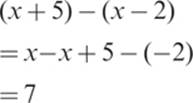
4. The correct answer is K. To solve this problem, substitute 15 for b in the equation:
4(15) – 30
= 60 – 30
= 30
5. The correct answer is C. The price of the carton of soda is currently $6.60, but will be reduced by 20% when it goes on sale. The decimal form of 20% is .20. In order to find the sale price, perform the following operations:
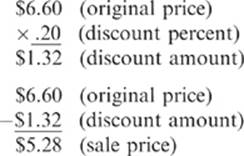
6. The correct answer is K. To find the value of a and b, first find the square root of 64 and 81. Since a negative number squared results in a positive number, consider both the negative and positive values:
![]()
Find all of the possibilities for a + b: –8 + —9 = – 17, 8 + –9 = –1, –8 + 9 = 1, and 8 + 9 = 17. This means that 145 is NOT a value of a + b, so answer choice K is correct.
7. The correct answer is D. Triangle BEF is an isosceles triangle with 2 congruent sides, ![]() and
and ![]() , and 2 angles with equal measure, BFE and BEF.
, and 2 angles with equal measure, BFE and BEF. ![]() is also the transversal between 2 parallel lines,
is also the transversal between 2 parallel lines, ![]() and
and ![]() , making angles CBF and BFE alternate interior angles, which are congruent. By definition, if angle CBF is 40°, angle BFE is also 40°. Since there are 180° in a line, angle BFG must equal 180° – 40°, or 140°.
, making angles CBF and BFE alternate interior angles, which are congruent. By definition, if angle CBF is 40°, angle BFE is also 40°. Since there are 180° in a line, angle BFG must equal 180° – 40°, or 140°.
8. The correct answer is F. Simply substitute –3 for x wherever x appears in the equation and solve the equation. Don’t forget to keep track of the negative signs!
(–3)2 – 6(–3) – 18
= (9) – (–18) – 18
= 9 + 18 – 18
= 9 + 0
= 9
9. The correct answer is C. In order to solve this problem, you must first substitute the number 12 for the a in |1–a|, so that you get |1–12|. Then, perform the operation within the vertical lines to get |–11|. Since you must disregard the negative sign in order to determine absolute value, the absolute value of –11 is 11.
10. The correct answer is J. To solve this problem, substitute kb for c in the first equation and solve for k:

11. The correct answer is A. According to the law of exponents, (xa)b = x(a×b). So, (x3)13 is equal to x(3 × 13), or x39.
12. The correct answer is H. The easiest way to solve this problem is to plug the answer choices into the inequality and solve. Because the question asks you for the largest possible value of x, start with the largest answer choice (note that the answer choices are in ascending order):

Try the next largest number:

Try the next largest number:
![]()
This satisfies the inequality and is the largest remaining answer choice, so answer choice H must be correct.
13. The correct answer is D. There are 360 degrees in a circle. To calculate the number of degrees in 5 of the 12 sectors, perform the following operations:
360° ÷ 12 = 30°. Each sector is equivalent to 30°.
30° × 5 (the number of sectors) = 150°
14. The correct answer is G. To solve this problem, calculate the average by first finding the total number of students who entered through the main entrance that week:
(450 + 427 + 462 + 433 + 398) = 2,170
Next, divide by the number of school days:
2,170 ÷ 5 = 434
15. The correct answer is A. To solve this problem, set each element of the equations in the answer choices equal to 0 and solve for x, starting with answer choice A:
(x –6) = 0; x = 6
(x + 3) = 0; x = –3
Since this equation has solutions of 6 and –3, answer choice A is correct.
16. The correct answer is H. This problem requires you to solve for x. Perform the operations and simplify as much as possible:
First, distribute the –2 to get –2(x – 10) = –2x– (–20); this simplifies to –2x + 20.
Then, add the 7 back in to get 7 + (—2x) + 20, or –2x + 27.
17. The correct answer is D. The first step in selecting the correct answer to this problem is to recognize that x cannot be less than 90. This means that answer choices A, B, and C can be eliminated. Set up a proportion to calculate the correct answer:
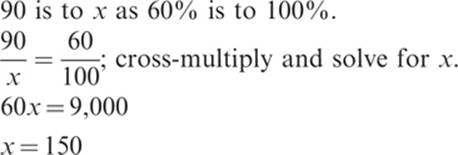
18. The correct answer is G. To solve this problem, calculate the price of 1 box of popcorn and subtract it from the price of 1 box of popcorn and 1 drink.
$8.35 (2 boxes and 1 drink) – $5.10 (1 box and 1 drink) = $3.25 (1 box of popcorn)
$5.10 (1 box and 1 drink) – $3.25 (1 box of popcorn) = $1.85
The price of 1 drink is $1.85.
19. The correct answer is A. In order to solve this problem you must first calculate the total cost of the lamps, including tax. Since the sales tax is 7%, multiply the price of the 2 lamps ($8.99 x 2) by 0.07, the decimal equivalent of 7%:
$8.99 x 2 = $17.98
$17.98 x 0.07 = 1.2586
$1.2586 rounded to the nearest cent is $1.26.
Now, add the sales tax to the price of the lamps:
$17.98 + $1.26 = $19.24
Based on these calculations, you will need $0.24 in exact change.
20. The correct answer is G. To solve this problem, find the cube root of 343, then multiply it by 3:
r3 = 343
r = 7
3r = 21
You could have quickly eliminated answer choice J because it is too large. Cubing a number typically results in a value greater than the value obtained when multiplying the number by 3. Likewise, you could have eliminated answer choices F and H, because neither 7 nor 49 is divisible by 3.
21. The correct answer is B. In order to solve this problem you must know that π is approximately equal to 3.14. The next step is to find the value of the fractions ![]() and
and ![]() . To do this, divide the numerators by the denominators: 7 ÷ 3 = 2.33 and 9 ÷ 2 = 4.5. Now, put the values in order from least to greatest: 2.33 < 3.14 < 4.5, or
. To do this, divide the numerators by the denominators: 7 ÷ 3 = 2.33 and 9 ÷ 2 = 4.5. Now, put the values in order from least to greatest: 2.33 < 3.14 < 4.5, or ![]()
22. The correct answer is J. The question can be solved using the following equation: ![]() Cross-multiply to get 4(9 + x) = 3(13 + x). Solve for x:
Cross-multiply to get 4(9 + x) = 3(13 + x). Solve for x:
4(9 + x) = 3(13 + x)
36 + 4x = 39 + 3x
4x – 3x = 39–6
x = 3
23. The correct answer is B. The slope of a line is the rise of the line over the run of the line (rise/run). Rise represents the change in y, and run represents the change in x. Two points on the line are given: (5,4) and (2, –7). The yvalues are 4 and –7, so the change in y is 4 – (–7), or 4 + 7, which is 11. The x values are 5 and 2, so the change in x is 5 – 2, or 3. The slope is ![]()
24. The correct answer is H. To solve this problem, list the prime factors for both 38 and 100:
Prime factors of 38: 1, 2, 19
The largest prime factor of 38 (p) is 19, so the correct answer must be greater than 19; eliminate answer choices F and G.
Prime factors of 100: 1, 2, 5
The largest prime factor of 100 (f) is 5, so p + f = 19 + 5 = 24.
25. The correct answer is E. The key to solving this problem is to recognize that, if (t + v)2 = 289, then t + v must equal 17, because 172 equals 289. Now, since you are given that tv = 30, you need to find 2 numbers that, when added together give you 17, and when multiplied together give you 30. The only 2 numbers that will satisfy both operations are 15 and 2. Substitute 15 for t and 2 for v in the final equation:
152 + 22
225 + 4 = 229
26. The correct answer is G. When exponents are raised to an exponential power, the rules state that you must multiply the exponents by the power to which they are raised. In this problem, x is raised to the (3a + 5) power. This exponent is then raised to the fourth power, so you should multiply 3a + 5 by 4: 4(3a + 5) = 12a + 20. You now have the equation x12a + 20 = x44. Since the bases are equal (x), the exponents must also be equal, so 12a + 20 = 44. Solve for a:
12a + 20 = 44
12a = 24
![]()
27. The correct answer is B. Logarithms are used to indicate exponents of certain numbers called bases. This problem tells you that log to the base x of 16 equals 2. By definition, logab = c, if ac = b. So logx 16 = 2 when x2 = 16. Since the square root of 16 is 4, answer choice B is correct.
28. The correct answer is J. To solve this problem you can use the Midpoint Formula. The midpoint of a line, M, is equal to the average of the x-coordinates and the average of the y-coordinates. The formula looks like this:
![]()
You are given 1 point on the line, (–2, 9) and the midpoint of the line (4,4). Since the midpoint is (4,4) the average of the x-coordinates is 4, and the average of the y-coordinates is 4. Set up equations to solve for the other endpoint:
![]()
8 = –2 + x2
10 = x2
The x-coordinate of the other endpoint is 10. Since only answer choice J includes an x-coordinate of 10, it must be the correct answer. If you solve for the y-coordinate in the same way that you solved for the x-coordinate, you will get y = –1.
29. The correct answer is D. A circle centered at (a,b) with a radius r, has the equation (x – a)2 + (y – b)2 = r2. Based on this definition, a circle with the equation (x – 4)2 + (y + 1)2 = 14 would have a radius of ![]() If r2 = 14, then r =
If r2 = 14, then r = ![]()
30. The correct answer is H. The cosine of any angle is calculated by dividing the length of the side adjacent to the acute angle by the hypotenuse ![]() so the cos
so the cos ![]() To find the length of the hypotenuse, use the Pythagorean Theorem, a2 + b2 = c2:
To find the length of the hypotenuse, use the Pythagorean Theorem, a2 + b2 = c2:
122 + 52 = c2
144 + 25 = 169 = c2
![]() so c = 13
so c = 13
The cos of ![]()
31. The correct answer is B. You should think of this problem as a basic fraction, where (13a2b4) (—8a3b5) is the numerator and (4a2b6) is the denominator. The first step is to multiply together the 2 elements in the numerator, as follows:
When multiplying exponents, the rules state that you should add exponents with like bases, so (13a2b4)(—8a3b5) = –104a5b9.
To solve a fraction, you simply divide the numerator by the denominator.
When dividing exponents, the rules state that you should subtract exponents of the same bases in the denominator from the exponents of the same bases in the numerator, so –104a5b9 ÷ (4a2b6) = –26a3b3.
32. The correct answer is K. By definition, a right isosceles triangle has 2 sides of equal length, and the hypotenuse is equal to ![]() times the length of either of the sides (only for a right isosceles triangle). Therefore, a right isosceles triangle could have side lengths equal to 2, 2, and 2
times the length of either of the sides (only for a right isosceles triangle). Therefore, a right isosceles triangle could have side lengths equal to 2, 2, and 2 ![]() , answer choice K.
, answer choice K.
33. The correct answer is C. In the point-slope form of a line, y = mx + b, b is the y-intercept. The first step in solving this problem is to put the equation in the point-slope form, as follows:

As you can see, the y-intercept is ![]() .
.
34. The correct answer is F. According to the graph shown, the number –4 is included, but the number 6 is not included. This means that x must be greater than or equal to –4 (x ≥–4) and/or x must be less than 6 (x < 6). Since the sets overlap on the graph, the correct answer is x ≥–4 and x < 6.
35. The correct answer is B. You are given that the figure is drawn to scale, so you know that if the square shown had a bottom, it would also be 6 units (see figure below):
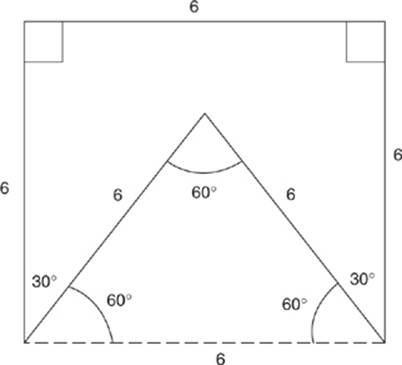
You also know that the angles created by drawing the bottom of the square must be 60° because they are complementary to the 30° shown. Because there are 180° in a triangle, the top angle must also be 60°, thereby creating an equilateral triangle. An equilateral triangle has congruent sides, which means that each side measures 6 units, and the perimeter of the original figure is 6 × 5 = 30.
36. The correct answer is H. Because a negative number cannot have a square root, the value under a square root sign must be positive. In this problem, the value under the square root sign is ![]() Choose values for the answer choices and eliminate those choices that could give you a negative value under the square root sign:
Choose values for the answer choices and eliminate those choices that could give you a negative value under the square root sign:
If x is negative, then x3 will be negative. If y is also negative, then 2y will also be negative, so the value under the square root sign will be positive. Answer choice F will work.
If x is positive, then x3 will be positive. If y is also positive, then 2y will also be positive, so the value under the square root sign will be positive. Answer choice G will also work.
Answer choices J and K are not true, because you have just determined that both x and y must both be either positive or negative.
Since answer choices F and G cannot both be correct, you are left with answer choice H.
37. The correct answer is D. The question asks you to solve for S, so perform the following operations:

38. The correct answer is G. Calculate the slope by using the following formula:![]() . Any line perpendicular to the y-axis is a horizontal line. Because there is no change in y, the numerator (y1 – y2), is 0. This means that the slope of a horizontal line is 0, answer choice G.
. Any line perpendicular to the y-axis is a horizontal line. Because there is no change in y, the numerator (y1 – y2), is 0. This means that the slope of a horizontal line is 0, answer choice G.
39. The correct answer is D. To solve this problem, recall that wherever a line crosses the x-axis, the y-coordinate is 0. Substitute 0 for y in the equation and solve for x:
5 × 0 = 25x –50
0 = 25x –50
50 = 25x
x=2
40. The correct answer is K. To solve this problem, you must calculate the tan α and the cos β. The tangent of any acute angle is calculated by dividing the length of the side opposite the acute angle by the length of the side adjacent to the acute angle ![]() The cosine of any acute angle is calculated by dividing the length of the side adjacent to the acute angle by the hypotenuse
The cosine of any acute angle is calculated by dividing the length of the side adjacent to the acute angle by the hypotenuse ![]() The tan of angle α is
The tan of angle α is ![]() , and the cos of angle β is
, and the cos of angle β is ![]() . Now you can substitute these values into the equation given in the problem and solve:
. Now you can substitute these values into the equation given in the problem and solve:
![]()
41. The correct answer is E. According to information in the problem, Amy can run 3 miles in s minutes, or ![]() The question asks you to calculate the distance she can run in 50 minutes. Set up a proportion and solve for x:
The question asks you to calculate the distance she can run in 50 minutes. Set up a proportion and solve for x:

42. The correct answer is J. The problem states that each gallon of oil weighs 6 pounds. Multiply the number of pounds per gallon (6) by the number of gallons that the tank contains (4,800):
6 × 4,800 = 28,800
43. The correct answer is C. The area of a triangle is calculated using the formula A =![]() (bh), where b is the length of the base, and h is the height. Based on the measures of the angles given, you can draw triangle ABC as shown below:
(bh), where b is the length of the base, and h is the height. Based on the measures of the angles given, you can draw triangle ABC as shown below:
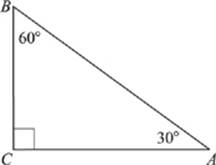
You are given that ![]() , the hypotenuse, is 16 units long. Because this is a 30°–60°–90° triangle, you can calculate the lengths of the height
, the hypotenuse, is 16 units long. Because this is a 30°–60°–90° triangle, you can calculate the lengths of the height ![]() and the base (
and the base (![]() ). The relationship between the sides of a 30°–60°–90° triangle is as follows: The side opposite the 30° is equal to
). The relationship between the sides of a 30°–60°–90° triangle is as follows: The side opposite the 30° is equal to ![]() of the length of the hypotenuse, and the side opposite the 60° is equal to
of the length of the hypotenuse, and the side opposite the 60° is equal to ![]() of the length of the hypotenuse times
of the length of the hypotenuse times ![]() . Calculate the lengths of the sides:
. Calculate the lengths of the sides:

Now you can substitute these values into the formula for the area of a triangle:
![]()
44. The correct answer is F. Perpendicular lines have negative reciprocal slopes. The equation of the line given is y = 2x + 1, so the slope is 2. The slope of a line perpendicular to this line will have a slope equal to –1/2. Only answer choice F has a slope equal to –1/2, so it must be the correct choice.
45. The correct answer is C. The area of a rectangle is calculated by multiplying the width by the length (A = w × I). Calculate the area of the first rectangle as follows:
Set the width equal to x, and the length equal to 2x.
A = x(2x) = 2x2
Now calculate the area of the second rectangle:
The length is tripled and the width is doubled, so the length = 3(2x) and the width = 2x.
A = 3(2x)(2x) = 6x(2x) = 12x2
The area of the second triangle is 12x2, which is 6 times greater than the area of the first triangle (2x2).
46. The correct answer is J. Systems of equations will have an infinite number of solutions when the equations are equal to each other. The first step in solving this problem is to recognize that the second equation is exactly 3 times the value of the first equation: 72x = 3(24x), 45y = 3(15y), so 9z must equal 3(108). Solve for z:
9z = 3(108)
9z = 324
z = 36
47. The correct answer is B. A prime number is a number that is only divisible by 1 and itself. If you list all of the numbers between 36 and 54, not including 36 and 54, you will find the prime numbers 37, 41, 43, 47, and 53. There are 5 prime numbers between 36 and 54.
48. The correct answer is H. The tangent of any acute angle is calculated by dividing the length of the side opposite the acute angle by the length of the side adjacent to the acute angle ![]() The sine of any acute angle is calculated by dividing the length of the side opposite to the acute angle by the hypotenuse
The sine of any acute angle is calculated by dividing the length of the side opposite to the acute angle by the hypotenuse ![]() If tan
If tan ![]() , then sin
, then sin ![]() To determine the length of the hypotenuse, use the Pythagorean Theorem, a2 + b2 = c2. According to this equation, a2 + b2 = x2 + y2, so c2 = x2 + y2, and
To determine the length of the hypotenuse, use the Pythagorean Theorem, a2 + b2 = c2. According to this equation, a2 + b2 = x2 + y2, so c2 = x2 + y2, and ![]() Now that you know the value of the hypotenuse, you can solve for sin A. sin A is
Now that you know the value of the hypotenuse, you can solve for sin A. sin A is ![]()
49. The correct answer is B. To solve this problem, you must first recognize that there are 360 degrees in a circle. Next, set up a ratio to calculate the number of degrees represented by Aishah’s time playing the piano:
1.5 is to 24 as x is to 360.
![]()
24x = 540
x = 22.5
50. The correct answer is H. The easiest way to solve this problem is to draw a line and place the given points on the line, as follows:
![]()
Based on the line above, 1 possible length of AC is 20. Eliminate answer choices G, J, and K. Since you are left with answer choices F and H, you need to determine if AC could also be 2 meters long. Draw another line, and change the order of the points:

Based on this line, another possible length of AC is 2, so answer choice H must be correct.
51. The correct answer is E. To solve this problem, first recall that there are 360 degrees in a circle. The sector shown is equal to 30°, so it is 1/12 of the total circle. Likewise, the arc represents 1/12 of the total circumference of the circle. The formula for the circumference of a circle is C = 2πr, so the circumference of the circle is 12(6π) = 2πr. Solve for r as shown next:
12(6π) = 2πr
72π = 2πr
36 = r
You now know that the radius of the circle is 36. The formula for area of a circle is A = πr2. Calculate the area of the circle as shown next:
A = π (36)2
A = 1,296 π
Because sector LMN is 1/12 of the total area of the circle, the area of sector LMN is 1,296 ÷ 12 = 108.
52. The correct answer is G. In this problem, the quantity 6a5b7 is less than 0, which means it must be negative. 6 is positive and a5 and b7 can be positive or negative. Since a negative number times a negative number yields a positive number, either a5 or b7 must be negative, but not both. Eliminate answer choice F. By definition, if you raise a negative number to an odd numbered power, the result will be negative. Since the problem asks which must be true, answer choice G is correct because it makes either a or b negative, but not both.
53. The correct answer is C. The easiest way to solve this problem is to determine the number of patients Mandy visited each day and calculate the total number of visits on all 5 days:
Day 1: 7 visits
Day 2: 7 + 3 = 10 visits
Day 3: 10 + 3 = 13 visits
Day 4: 13 + 3 = 16 visits
Day 5: 16 + 3 = 19 visits
7 + 10 + 13 + 16 + 19 = 65 visits.
54. The correct answer is K. If 2 numbers, x and y, differ by 8, that means that x – y = 8. Multiplying the 2 numbers, (x)(y), will yield the product. Solve the first equation for x:
x – y = 8
x = y + 8
Substitute the result for x in the second equation, as follows:
(y + 8)y
Since one of the answer choices must be the solution to that equation, plug in the answer choices, starting with the smallest value (note that the answer choices are in descending order):
(y + 8) y = –16
y2 + 8y = –16
y2 + 8y + 16 = 0
(y + 4)2 = 0
y = –4
Now, substitute –4 for y in the first equation and solve for x:
x – (–4) = 8
x = 4
Since (4)(–4) = –16, answer choice K is correct.
55. The correct answer is A. Because angle x is less than 90°, it is an acute angle. The cosine of any acute angle is calculated by dividing the length of the side adjacent to the acute angle by the hypotenuse ![]() This means that the length of the side adjacent to angle x is 4, and the length of the hypotenuse is 5. The sine of any acute angle is calculated by dividing the length of the side opposite to the acute angle by the opp hypotenuse
This means that the length of the side adjacent to angle x is 4, and the length of the hypotenuse is 5. The sine of any acute angle is calculated by dividing the length of the side opposite to the acute angle by the opp hypotenuse ![]() Since you know the measure of the side adjacent to angle x and the length of the hypotenuse, you can use the Pythagorean Theorem to calculate the length of the side opposite angle x.
Since you know the measure of the side adjacent to angle x and the length of the hypotenuse, you can use the Pythagorean Theorem to calculate the length of the side opposite angle x.
Pythagorean Theorem: a2 + b2 = c2, where c is the hypotenuse.
42+b2 = 52
16+b2 = 25
b2 = 9
b = 3
The side opposite angle x is 3, so the sine of angle x is ![]() .
.
56. The correct answer is F. The problem asks for an expression that represents the number of sets of books sold, not the price of the sets of books sold. One way to understand the problem is to make a table and notice the pattern:

57. The correct answer is A. The rules of the game state that a player is a winner if 2 marbles drawn have a sum greater than 45. Martin has already drawn the marble numbered 17. In order to win, Martin must draw another marble with a number greater than 28 (17 + 28 = 45). The possible winning marbles are 29, 30, 31 … 44. Therefore, Martin has 16 chances to draw a winning marble. Since he has already drawn one of the 45 marbles and did not put it back, he has 16 chances out of 44 to draw a winning marble. ![]() can be reduced to
can be reduced to ![]() .
.
58. The correct answer is F. The perimeter is the distance around an object. Calculate the perimeter by adding the lengths of the sides. First, find the missing lengths:
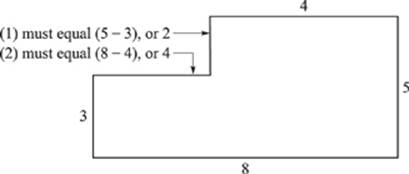
The perimeter is 3 + 4 + 5 + 8 + 2 + 4, which is 26.
59. The correct answer is C. A circle that is inscribed in the square will be contained completely inside the square, and will touch all 4 sides of the square. Draw a picture to help you visualize the problem:
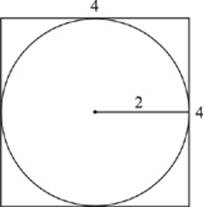
If the vertices, or corners of the square, are at the coordinates given, the length of each of the sides of the square must be 4. This means that the diameter of the circle is 4, and the radius is 2. The equation of a circle centered at (a,b) with a radius r, is (x – a)2 + (y – b)2 = r2. Substitute 2 for r and get a value of 4 for r2. You can eliminate answer choices A, B, and E, which indicate that r2 is equal to either 2 or 8. Answer choice C matches the standard form of the equation of a circle, so it is the correct choice.
60. The correct answer is K. According to the question, on Wednesday, the original price ($60) was reduced by 15%. This means that the price on Wednesday was 100% –15%, or 85% of $60. Multiply $60 by 0.85, the decimal equivalent of 85%, to get $51. Two weeks later, this price ($51) is further reduced by 20%. Calculate this reduced price:
100%–20% = 80%
($51) 0.80 = $40.80
Set up a proportion to calculate the percent this price is of the original price:
$40.80 is to $60 as x% is to 100%
![]() cross-multiply and solve for x.
cross-multiply and solve for x.
60x = 4,080
x = 68
Reading Test Explanations
PASSAGE I
1. The best answer is A. The first sentence of the last paragraph indicates that it was time for Mrs. Pontellier to dress for dinner. She then makes the comment about her husband not returning, so it is most likely that she is expressing her belief that she will be having dinner without her husband, answer choice A.
2. The best answer is H. The fourth paragraph indicates that Robert talked a good deal about himself because “he was very young, and did not know any better.” The passage goes on to say that “Mrs. Pontellier talked a little about herself for the same reason.” You can infer that the two are about the same age, answer choice H.
3. The best answer is A. According to the passage, Robert intended to “go to Mexico in the autumn, where fortune awaited him.” This suggests that he wanted to seek his fortune in Mexico in order to gain more wealth and social stature than he currently has.
4. The best answer is G. The word incessantly means “long and uninterrupted.” This definition best supports answer choice G. Based on the context of the passage, you could have eliminated answer choices H and J. While it is true that they each talked about themselves, the use of the word incessantly suggests that the conversation was long.
5. The best answer is D. The only selection that is made clear in the passage about both Mrs. Pontellier and her husband is that they have children, answer choice D. There is no discussion about the way that Mr. Pontellier feels about Robert, or about how Mr. and Mrs. Pontellier get along. While the passage suggests that Mrs. Pontellier will not be having dinner with her husband, the passage does not make it clear that they never spend time together.
6. The best answer is G. In order to answer this question, it is necessary to understand the meaning of “countenance,” which can be defined as “the face as an indication of mood, emotion, or character.” If you did not know the definition, you could infer from the context of the sentence that “countenance” is related to the face, because the author details various characteristics of Robert’s face. The phrase “there rested no shadow of care” on Robert’s face implies that he seemed carefree and relaxed. Answer choices F and H do not make sense because they refer to the physicality of Robert’s face instead of his emotional state. Answer choice J is incorrect because stressed is actually the opposite of displaying “no shadow of care.”
7. The best answer is B. All of the characters in the story seem to enjoy the company of others, so it makes sense that they are all sociable, answer choice B. The other answer choices are not supported by details in the passage.
8. The best answer is F. According to the passage, Robert spoke of his intention to go to Mexico to make his fortune, “but somehow never got there,” so he “held on to his modest position.” This suggests that his ambitions are unfulfilled.
9. The best answer is A. According to the passage, “In former times … ‘the house’ had been a summer luxury of the LeBruns.” Now, the cottages surrounding the house were rented by visitors, which “enabled Madame LeBruns to maintain the easy and comfortable existence which appeared to be her birthright.” This suggests that Robert’s mother, Madame LeBruns, was better off financially earlier in her life, answer choice A.
10. The best answer is J. Mrs. Pontellier did not seem to be concerned that she would be dining without her husband, which suggests that she is accustomed to being without him. Her friendly and easy conversation with Robert also supports answer choice J. The other answer choices are not supported by the passage.
PASSAGE II
11. The best answer is B. The passage states that baleen is whalebone, which was used for things like storage and insulation, but not for food. All of the other answer choices are mentioned specifically as being part of the Inuit diet.
12. The best answer is G. According to the passage, when the moratorium on “all whaling” was imposed, “a great cry sounded from the Inuit,” whose lives depended on controlled hunting of whales. This information best supports answer choice G.
13. The best answer is D. The Inuit culture is tied to the environment, and the Inuit “believe the Arctic animals … are all part of their culture.” They have a great respect for the whales, and hunt only as many animals as they need to survive. This information best supports answer choice D.
14. The best answer is H. The passage explicitly states that whale meat is rich in phosphorous, niacin, and vitamin E. Riboflavin is not mentioned.
15. The best answer is C. In the first paragraph, the word moratorium is used in reference to the International Whaling Committee’s response to the overhunting of whales. Therefore, it makes sense that a moratorium would be a suspension of activity. The other answer choices are not supported by the passage.
16. The best answer is F. According to the passage, Naluqatak is a feast that is celebrated at the end of the whaling season. It is a “time of thanksgiving and sharing.” Therefore, it can best be described as a harvest feast, answer choice F.
17. The best answer is C. The sixth paragraph indicates that the traditional blanket toss “requires the coordinated action of many people … creating a communal version of a trampoline.” The use of the word coordinated refers to the organized movement of the people, answer choice C.
18. The best answer is F. A main theme of the passage is the importance of family and community to the Inuit people. It would make sense, then, that the Inuit would respect their elders, answer choice F. The passage also states that the shares of the whale meat are “reserved for elders and widows.” The other answer choices are somewhat negative, and do not fit within the context of the passage.
19. The best answer is A. The passage states that “many Inuit never hunt beyond the end of May, to avoid the time when calving females are passing through.”
20. The best answer is J. According to the passage, “meat from seals and fish” is saved for festivals. You can conclude that the Inuit also hunt seals, answer choice J.
PASSAGE III
21. The best answer is B. The passage indicates that, like Tiger Woods, Bobby Jones was also a very talented golfer at a young age. Tiger Woods entitled his book, How I Play Golf, which was the same title that Bobby Jones used for his instructional film series. These, and other details from the passage, suggest that both of the men were similar in many ways, answer choice B.
22. The best answer is J. The second paragraph states that “Pop” Keeler was a mentor for Bobby, and helped Bobby to become a gracious winner and loser, as well as “a remarkably honorable gentleman.” This indicates that “Pop” Keeler was a positive force in Bobby’s life, answer choice J.
23. The best answer is C. The passage discusses many accomplishments that Jones made throughout his life, including furthering his education. The passage also mentions that Jones did not take lessons or practice constantly. Answer choices A, B, and D can be eliminated, because they are not supported by details in the passage.
24. The best answer is J. The first paragraph serves as an introductory paragraph and references the comparison between Tiger Woods and Bobby Jones. The rest of the passage discusses Bobby Jones’ many accomplishments and mentions several similarities between Tiger and Bobby.
25. The best answer is A. Since Jones took time away from golfing to earn his college degrees, it is clear that his perspective on higher education was that it was important. The other answer choices are not supported by the passage.
26. The best answer is G. The statement appears in the fourth paragraph, where Jones insisted on following the rules of the game, “adding a penalty stroke to his score.” This suggests that he placed as great an emphasis on the rules of golf as he did on the laws against crime.
27. The best answer is D. According to the passage, Bobby Jones “earned a varsity letter as the assistant manager of Harvard’s golf team. It is difficult to imagine one of today’s professional athletes volunteering to be the assistant manager of a college team!” These details best support the notion that Bobby Jones was more committed than today’s professional athletes.
28. The best answer is H. According to the passage, syringeomyelia is a rare spinal disease, which eventually confined Jones to a wheelchair. This suggests that the disease gradually left him incapacitated, answer choice H. He had retired from golf years earlier, so answer choice G can be eliminated. The other answer choices are not supported by the passage.
29. The best answer is B. Jones’ comment in the seventh paragraph was in response to a question about his debilitating disease.
30. The best answer is F. The overall tone of the passage is very positive, and indicates that the author admired and respected Bobby Jones. The other answer choices are not supported by the passage.
PASSAGE IV
31. The best answer is D. The word “certainly” can be used to indicate assurance. The author likely includes it here to indicate that there is no doubt about the value of robots as information gathering tools.
32. The best answer is J. The word “calibrating” can refer to measuring or determining the accuracy of information. The passage suggests that humans would be more useful than robots in adjusting equipment and manipulating data.
33. The best answer is C. The context of the passage suggests that one reason “Americans support government funding” of space exploration might be the need for Earth’s ever-expanding population to find another place to live.
34. The best answer is J. The space shuttle disaster and loss of the astronauts aboard the shuttle was a serious blow to manned space exploration. It is likely the author mentions the accident as a warning about the dangers of sending people into space.
35. The best answer is A. The word “lament” means to feel sorrow or regret. The author uses the word to suggest that there is no reason to be sad about the end of manned space exploration because unmanned exploration will continue.
36. The best answer is G. The phrase “computer-driven hunk of metal” invokes a sense of detachment, which shows the reader that unmanned space exploration is less dangerous than manned space exploration.
37. The best answer is C. The question deals with sparing humans from harm, making it clear that the author believes manned space flight is dangerous and that it is important to “embrace” the notion of astronauts being replaced by robots.
38. The best answer is H. An assumption is unstated evidence. While neither of the passages states that interest in potential life beyond Earth will continue, in order for the authors’ statements about space exploration to be logical, the continuation of such interest is necessary.
39. The best answer is C. According to Passage A, “Robots and astronauts use much of the same equipment in space, but a human is more capable of calibrating sensitive instruments correctly and placing them in appropriate and useful positions.” Additionally, “Robots are also not as well equipped as humans to solve problems as they arise, and robots often collect data that is unhelpful or irrelevant.” These concerns are not addressed in Passage B.
40. The best answer is G. The author of Passage A raises the question, “So what is that next level?” The author of Passage B talks about embracing new technology. Both authors seem to agree that space exploration will continue in some form.
Science Test Explanations
PASSAGE I
1. The correct answer is C. Table 1 shows that petri dish 2 had a pH level of 7 and experienced the highest percent growth of E. coli bacteria, as compared to petri dishes 1 and 2. Therefore, answer choice C, a pH level near 7, is correct.
2. The correct answer is F. The description of Experiment 3 indicates that most bacteria, unlike E. coli, need certain growth factors and vitamins to reproduce. In addition, the experiment was run to “ensure that the three growth factors have minimal to no effect on growth.”
3. The correct answer is A. Table 1 shows that E. coli bacteria reproduce most efficiently at a pH level of 7, so answer choice A is correct. Answer choice D is not correct because Table 1 shows that E. coli can still reproduce at different pH levels, just not as efficiently.
4. The correct answer is G. The question states that bacteria often reproduce until all available nutrients have been depleted. By supplying each group of bacteria with unlimited nutrients, the bacteria will reproduce for a longer time.
5. The correct answer is C. According to Table 2, petri dish 1, with the highest percent dry weight of the organic compounds (nutrients), yielded the highest percent growth of E. coli bacteria. This best supports the statement in answer choice C.
6. The correct answer is J. Since the reproduction rate varies drastically from one stage to the next, the best way to study the different growth stages would be to record the growth changes more frequently.
PASSAGE II
7. The correct answer is D. The major difference between the scientists’ opinions is whether or not earthquakes can be accurately predicted. Scientist 1 believes that predictions cannot be made with accuracy. Scientist 2 believes that accurate predictions can be made about the location and magnitude of the next earthquake.
8. The correct answer is G. Scientist 1 claims that Global Positioning Systems can determine the amount of strain that is loaded onto faults from plate motion “easily and with much certainty.” On the other hand, Scientist 1 claims that the amount of strain released is “much more difficult to estimate.”
9. The correct answer is C. According to Scientist 2, the movement of the tectonic plates is causing strain to build up. This claim best supports answer choice C.
10. The correct answer is G. Scientist 1 states that the main problem in predicting earthquakes is that historical data do not date back far enough to illustrate quake activities clearly. The other answer choices are not supported by the passage.
11. The correct answer is A. Scientist 2 claims that an earthquake is caused by the buildup of pressure on a fault line and the only way to release that pressure is through an earthquake. Therefore, if a handful of small earthquakes released some of the pressure along a fault line, there would be a decrease in the probability of another earthquake, answer choice A.
12. The correct answer is J. Based on their opinions, the only statement that both scientists would agree with is that the San Francisco Bay Area has fault lines extending through the entire region. Scientist 1 says that the Bay Area is covered with major fault lines and Scientist 2 says that many populated areas in the Bay Area are “near, or even sandwiched between,” major fault lines.
13. The correct answer is A. Scientist 2 claims that earthquakes can be predicted with much certainty. The only statement that strengthens his claim is answer choice A, which says that the predictions of a group of scientists were accurate.
PASSAGE III
14. The correct answer is G. Galvani claimed an electric fluid was present in animal tissue that created an electric current. Volta was trying to prove that you did not need animal tissue or electric fluid to create an electric current. By using his tongue, which is animal tissue, Volta did not disprove Galvani’s theory that animal tissue contains electric fluid.
15. The correct answer is B. Galvani used two metals in his experiment with the leg of the dead frog. Volta also believed that 2 metals were sufficient to produce an electric current, or he likely would have used a third metal in this experiment. The other answer choices are not supported by the passage.
16. The correct answer is J. Volta used several layers of the elements/metals piled on each other, separated by the moist material. We know that he used as many as 60 layers of metal to produce an electric current, which supports answer choice J.
17. The correct answer is A. According to Experiment 4, 60 layers of metal produced a greater intensity than 30 or 40 layers. It could be reasonably assumed that the greater the number of layers, the greater the intensity of the electric current.
18. The correct answer is G. In Experiment 2, Volta noted an electrical interaction between copper and zinc in an acidic solution. In Experiment 4, he separated layers of metal with material dampened by an acidic solution. If researchers were able to determine that substances used in the other two experiments (the human tongue and paper soaked in electrolytes) also contained an acidic solution, the hypothesis that an acidic solution is needed to create an electric current would be supported.
19. The correct answer is C. None of the experiments directly disprove the theory that a direct electric current is produced by chemical reactions. Volta only proved that animal tissue was not needed to produce electric currents. In fact, the first paragraph states that “Volta also discovered the means of converting chemical energy into electric energy which is the basis for the modern battery.”
PASSAGE IV
20. The correct answer is G. The passage states that high levels of chlorine are capable of having a corrosive effect on surfaces. The chlorine levels in Sample 2 are too high to fall into the ideal range, so it can be inferred that the water from Sample 2 may be corrosive.
21. The correct answer is A. According to Table 1, both the chlorine and bromine levels were within the ideal range for Sample 1, regardless of which kit was used. However, for both Kit A and Kit B, chlorine levels for Sample 2 were above the acceptable levels.
22. The correct answer is F. According to Table 1, the results from the tests on Sample 1 all fall within the ideal range, which most likely means that the water is balanced and safe for swimmers, answer choice F.
23. The correct answer is B. To answer this question, look at Figure 1. Find the point just above 80% on the y-axis and move to the right until you reach the line. Once you reach the line, move down until you arrive at the x-axis. The point on the x-axis that corresponds to this point on the line is a pH of 6.5, answer choice B.
24. The correct answer is H. According to the passage, Figure 1 shows the effectiveness of chlorine at different pH as a percentage of chlorine’s effectiveness at destroying harmful contaminants. The figure indicates that at a pH of 5, chlorine is 100% effective, while at a pH of 8, chlorine is less than 25% effective. This information best supports the statement that, as pH increases, the presence of harmful contaminants is most likely high.
PASSAGE V
25. The correct answer is C. According to Figure 1, anaerobic respiration is represented by the dashed line. The graph shows that, as intensity level increases moving to the right along the x-axis, the dashed line moves in a generally upward direction before leveling off. This indicates that the anaerobic respiration level increases and then levels off, answer choice C.
26. The correct answer is F. The passage states that aerobic respiration produces 18 times more ATP than anaerobic respiration. Therefore, if 2 moles of ATP were produced from anaerobic respiration, 36 moles would have been produced during aerobic respiration (2 × 18 = 36).
27. The correct answer is B. According to Table 1, the body first uses glycogen stores, then fat stores, and finally protein.
28. The correct answer is G. The question is asking you to look at Figure 2 and determine the VO2 max of a 50-year-old male in “Excellent” physical condition and compare it to a female of the same age and fitness level.
Find 50 on the x-axis (Age) and follow it up to the line that corresponds to a male in Excellent condition from the Key. Once you reach the line, move to the left until you reach the y-axis (VO2 max). This point is at a VO2 max of approximately 45.
Find 50 on the x-axis (Age) again and follow it up to the line that corresponds to a female in excellent condition from the Key. Once you reach the line, move to the left until you reach the y-axis (VO2 max). This point is at a VO2 max of approximately 33.
45 (male)–33 (female) = 12
The female consumes 12 milliliters less oxygen (per minute per kilogram of body weight), answer choice G.
29. The correct answer is A. Look at Figure 2 and find 27 on the x-axis (Age). Follow it up to the line that corresponds to a female in poor physical condition from the Key. Once you reach the line, move to the left until you reach the y-axis (VO2 max). This point is at a VO2 max of between 25 and 30, answer choice A.
PASSAGE VI
30. The correct answer is F. According to the passage, the body produces all of the cholesterol that it needs. Therefore, cholesterol is found in the body or in particular foods only. It can be inferred that any other cholesterol in the body that was not created there must come from what you eat, answer choice F.
31. The correct answer is A. HDL protects against the development of heart disease and is considered “good” cholesterol. Answer choice B says that HDL increases cholesterol levels and answer choice C claims that HDL is “bad” cholesterol, so you can eliminate both of these choices. You know from the passage that answer choice D is also false, so answer choice A must be correct. The passage also states that the liver is responsible for cholesterol from the body.
32. The correct answer is H. According to Table 1, trans fats are the only type of fats that increase “bad” LDL cholesterol and decrease “good” HDL cholesterol. Therefore, this type of fat would have the greatest net negative effect on cholesterol levels.
33. The correct answer is D. According to Table 1, monounsaturated and polyunsaturated fats are the best for overall cholesterol levels. Saturated and trans fats are the worst for overall cholesterol levels. Based on this information and the data in the question, you can eliminate answer choices A and B. Both palm and coconut oils have high amounts of saturated fats, which increase “bad” cholesterol levels. Canola oil is the best choice, but not because it is low in polyunsaturated fats, which increase “good” cholesterol levels, so answer choice C can also be eliminated. Canola oil is the best choice because it is high in monounsaturated and polyunsaturated fats and low in saturated fats, answer choice D.
34. The correct answer is J. According to the question, omega-3 fatty acid is known to lower the risk of heart disease. You know from the passage that high cholesterol levels can cause heart disease, so you can assume that omega-3 fatty acid lowers cholesterol levels. You can also assume that omega-3 fatty acids have lower amounts of “bad” LDL cholesterol and higher amounts of “good” HDL cholesterol. Therefore, lowering the level of “bad” LDL cholesterol and increasing the levels of “good” HDL cholesterol would probably lower the risk of heart disease.
PASSAGE VII
35. The correct answer is D. The passage states that friction depends mostly on the smoothness of the surfaces that come into contact with an object. Rough surfaces, like the carpet or driftwood used in the experiments, increase friction because it is harder for the car to travel on these surfaces than on a smoother surface. Therefore, the stronger the friction, the shorter the distance the car can travel, answer choice D.
36. The correct answer is F. The passage states that friction depends mostly on the smoothness of the surfaces that come into contact with an object. The smoother the surface, the less friction there will be to stop the car from traveling farther. If the surface is smoother, the friction will be decreased, and the car will be able to travel a longer distance, answer choice F.
37. The correct answer is C. According to the passage, friction depends mostly on the smoothness of the surfaces that come into contact with an object. Friction will be the least powerful on a smooth surface, like aluminum foil, answer choice C.
38. The correct answer is G. According to the passage, friction depends mostly on the smoothness of the surfaces that come into contact with an object. The smoother the surfaces of the two objects attempting to slide past one another, the less friction there will be to stop or slow the movement. Lubricants or oils cause the surface of an object to become slippery, or smoother, which is why the materials are used to decrease friction, answer choice G. The other answer choices are not supported by the passage.
39. The correct answer is A. The passage states that the same car was used in all of the experiments. Therefore, it can be inferred that the mass of the car was kept constant in each experiment, answer choice A.
40. The correct answer is H. The passage states that raising the height of the ramp increased the speed that the car could travel, so you can eliminate answer choices F and G. Based on information given in the passage and the results of the experiments, you know that the faster the car traveled, the longer the distance it traveled before friction stopped it. Therefore, increasing the height of the ramp both increased the speed and increased the distance traveled, answer choice H.